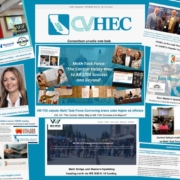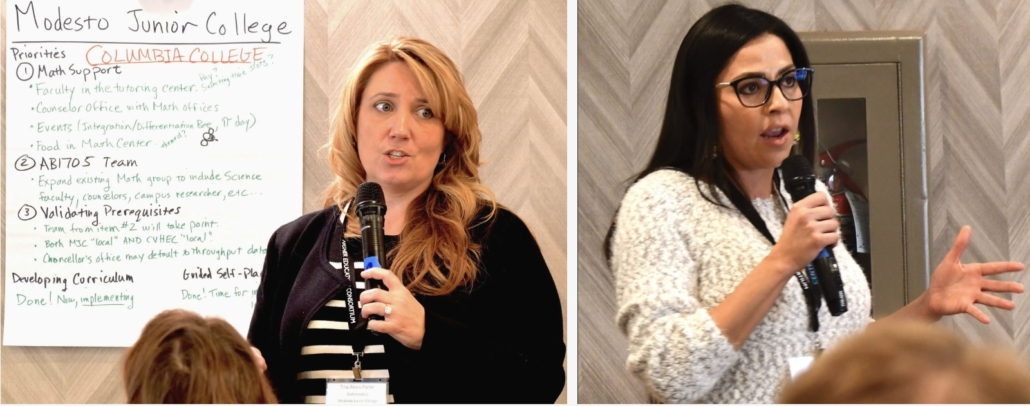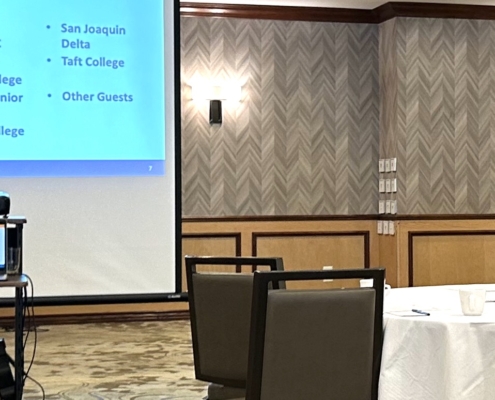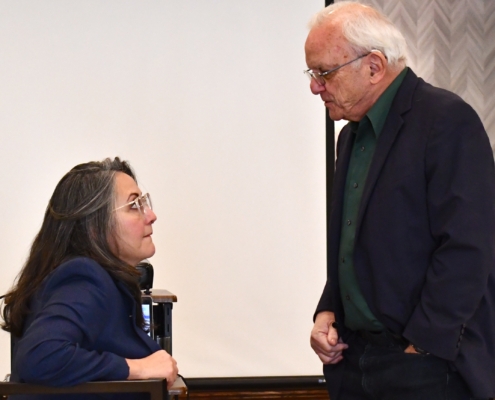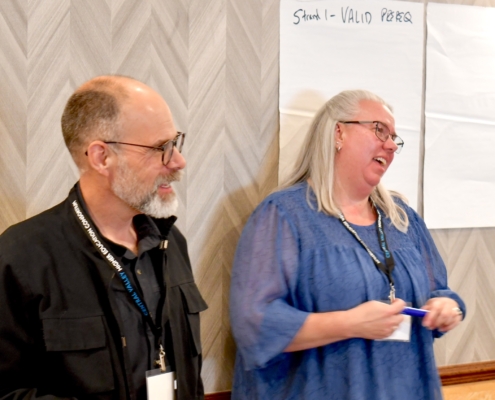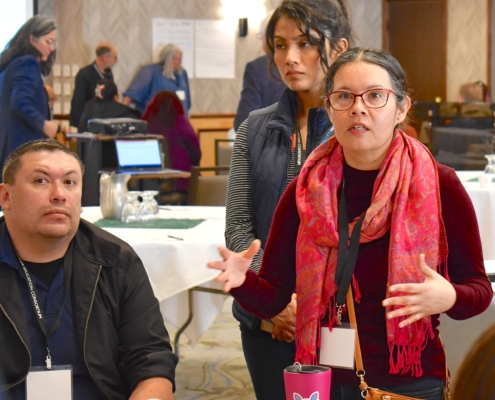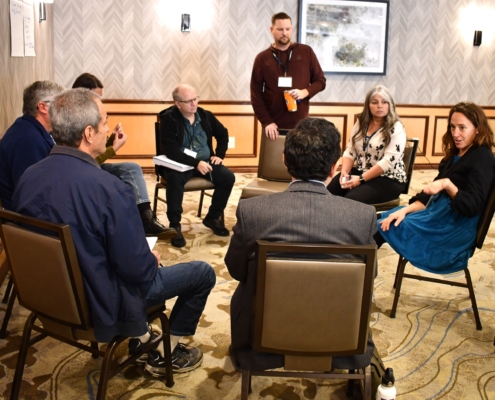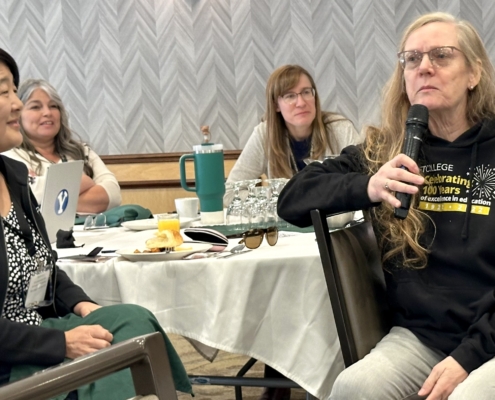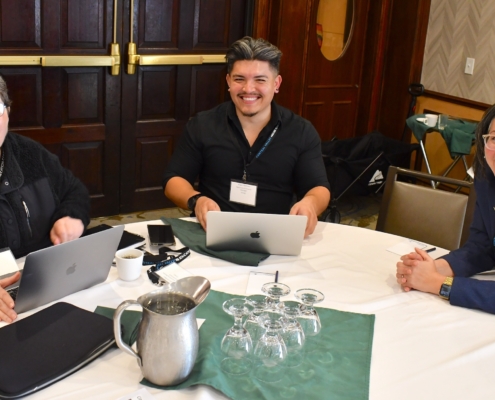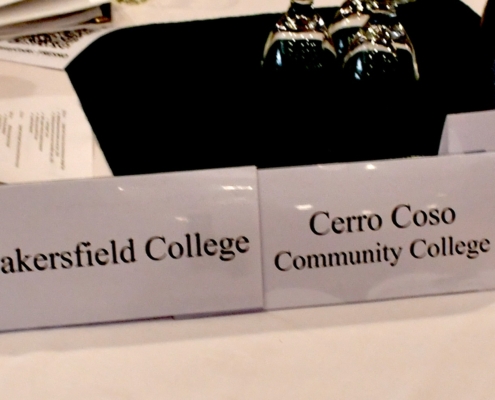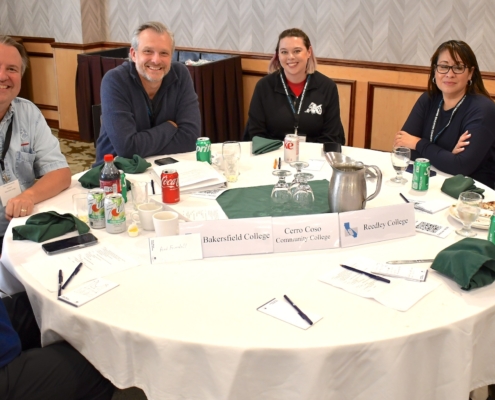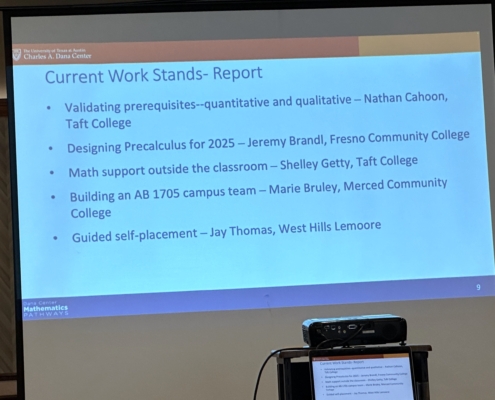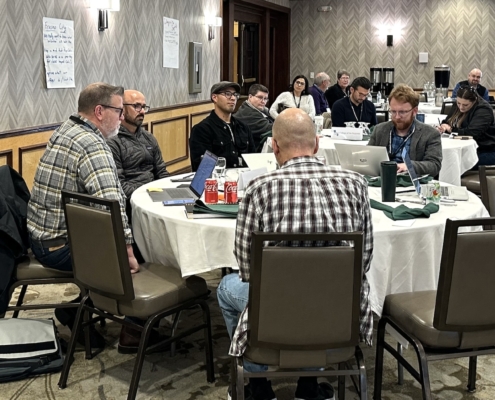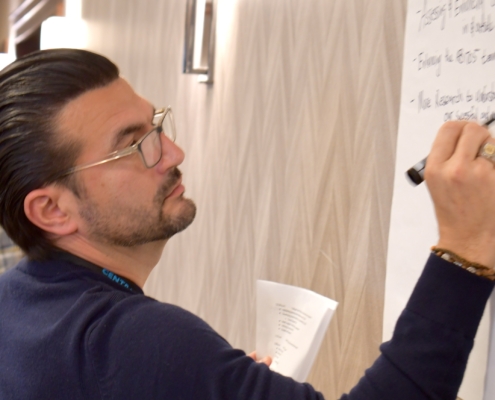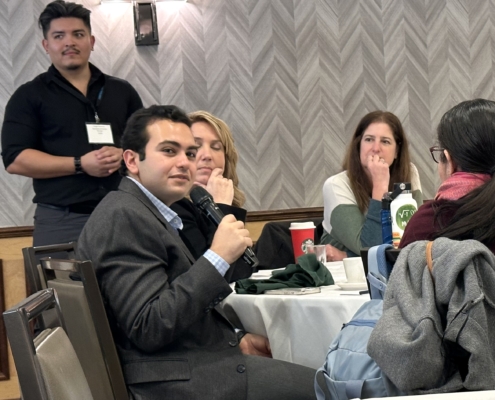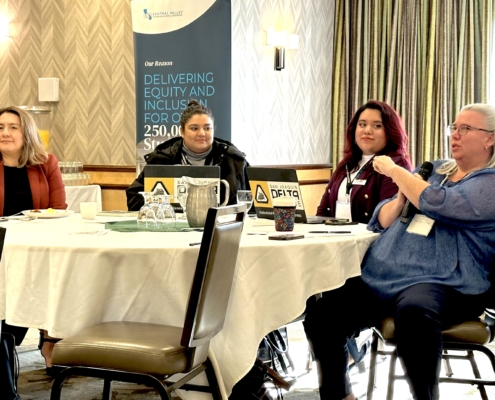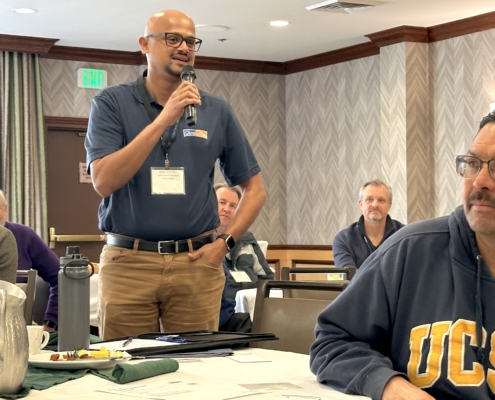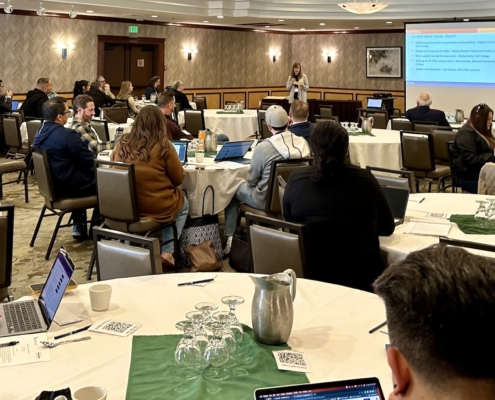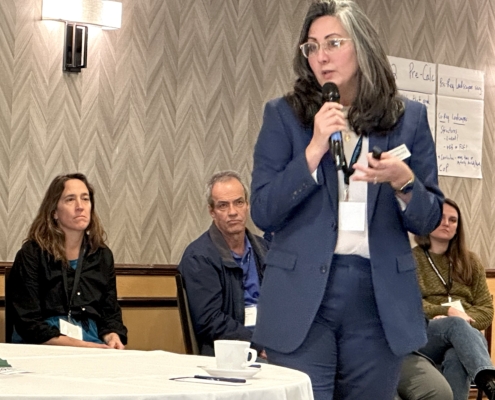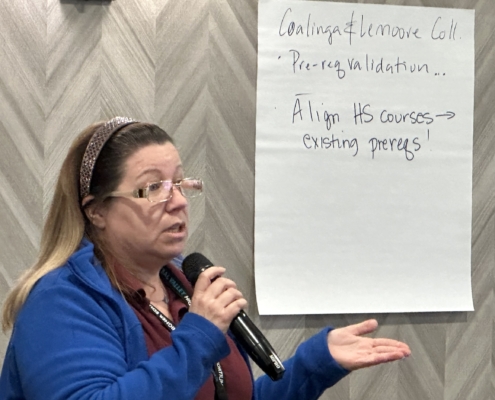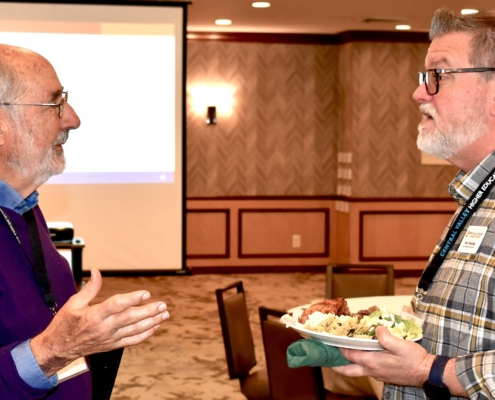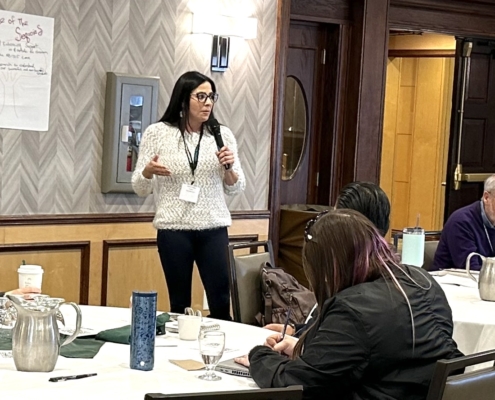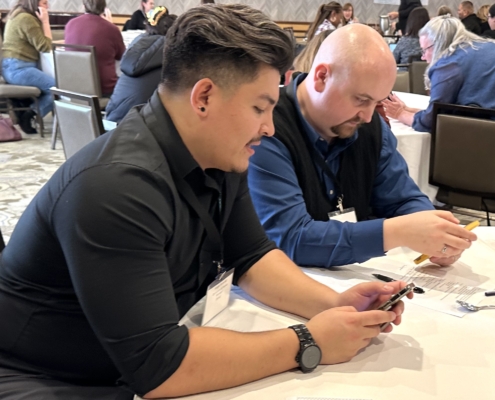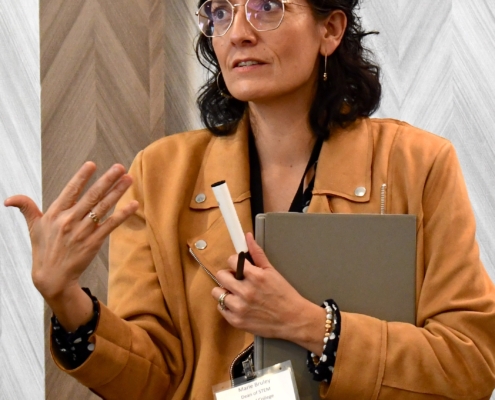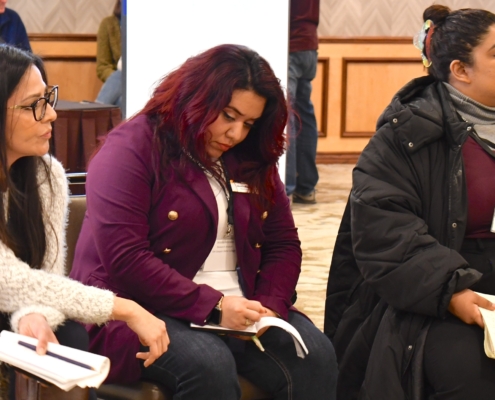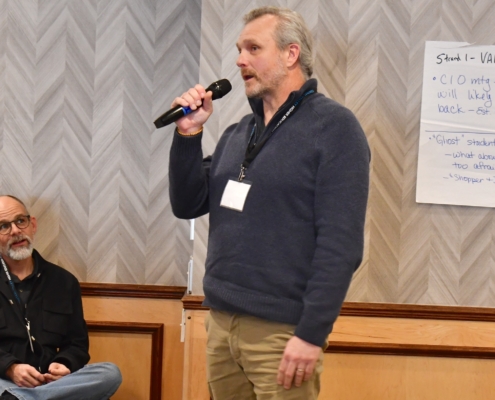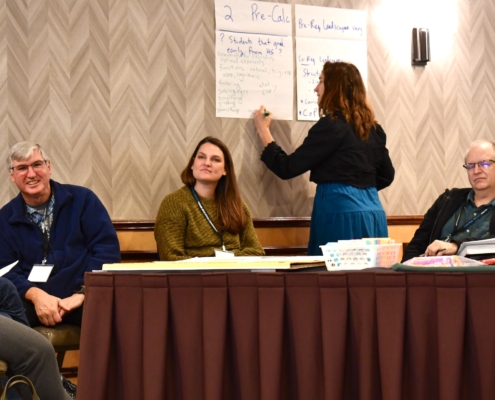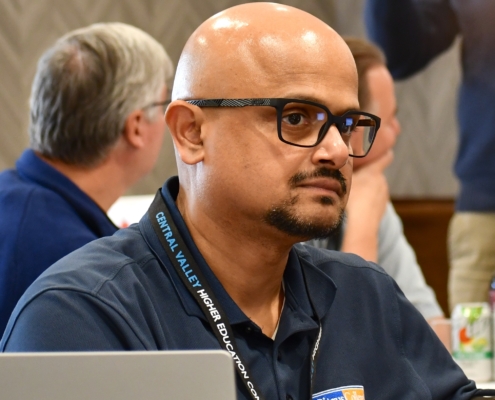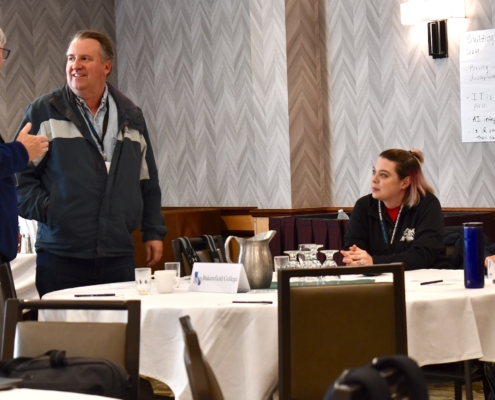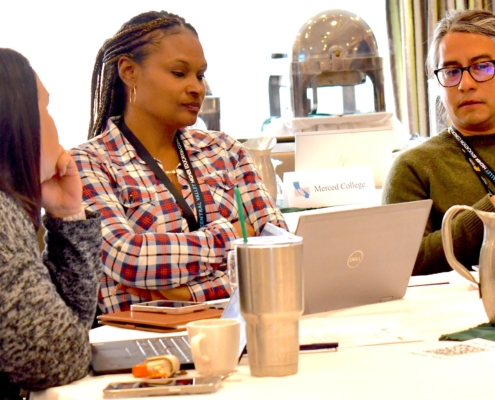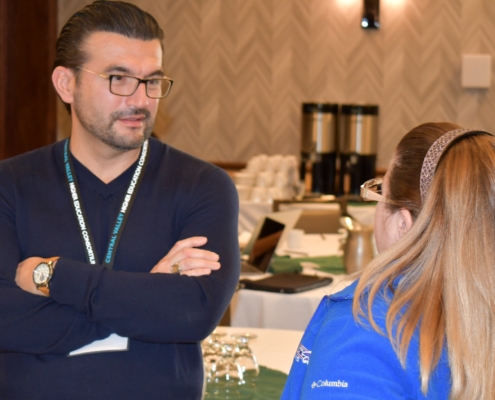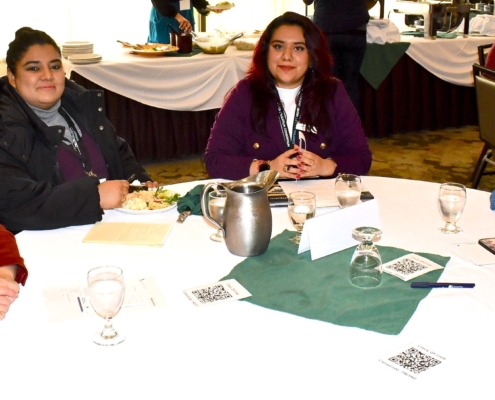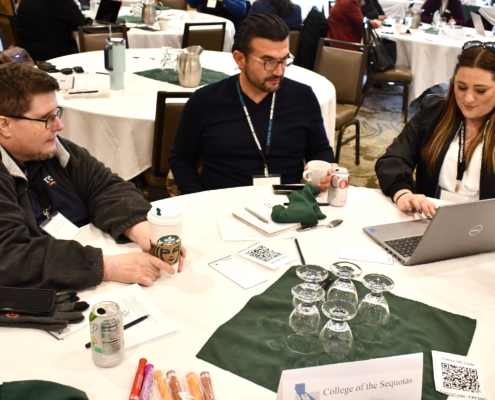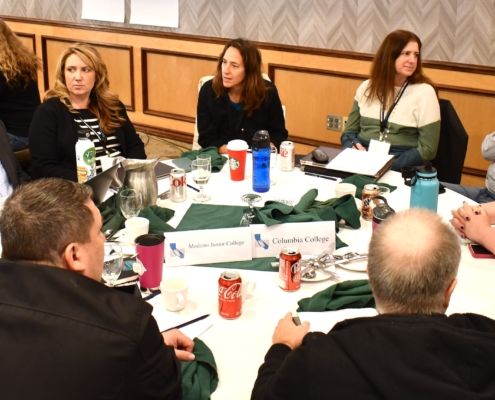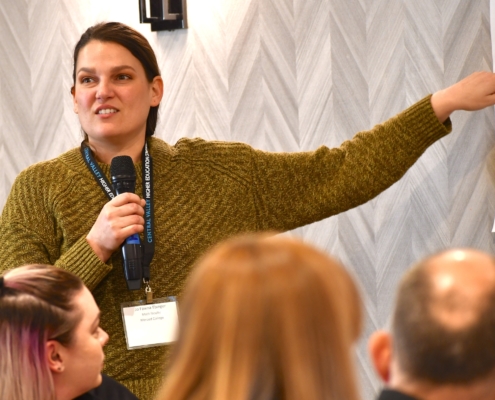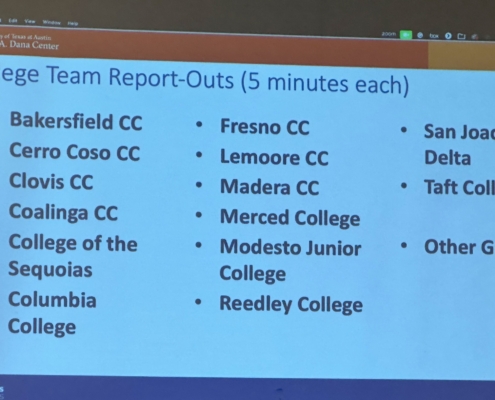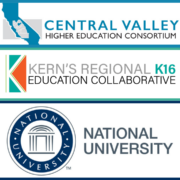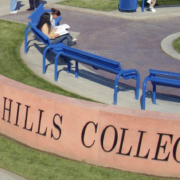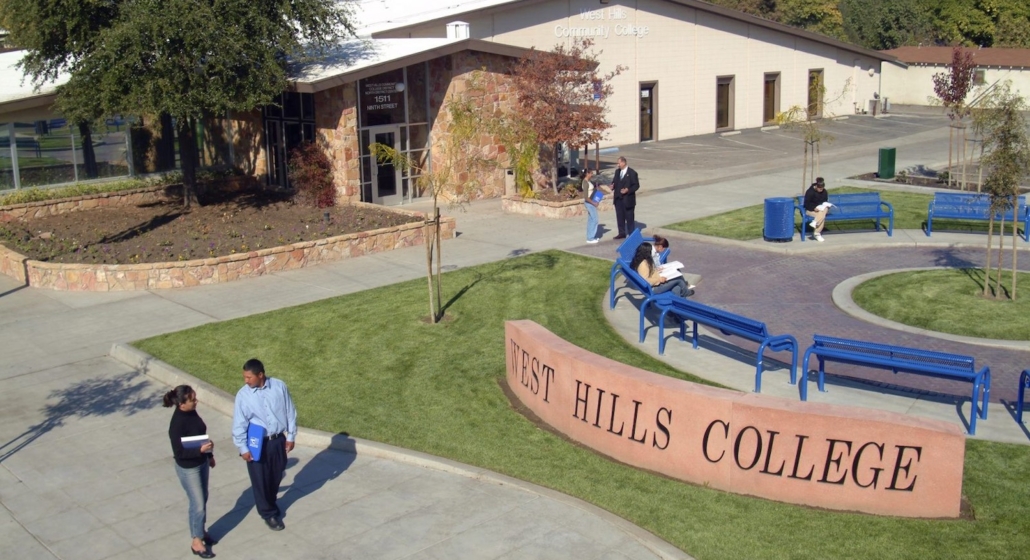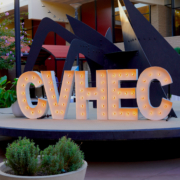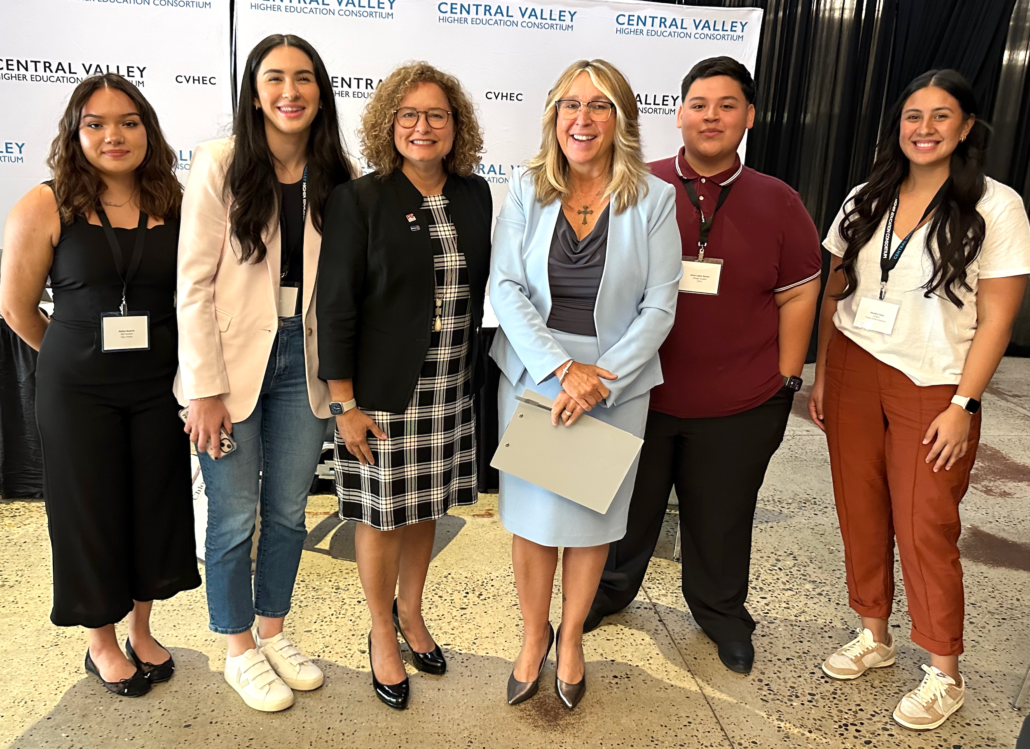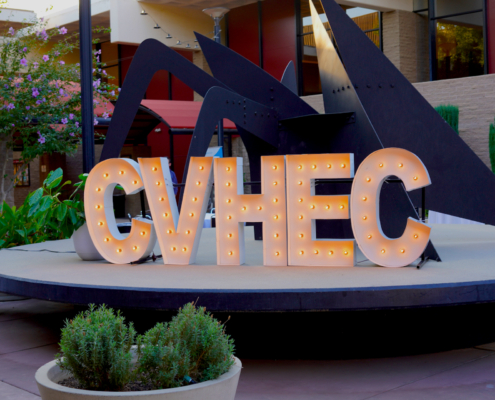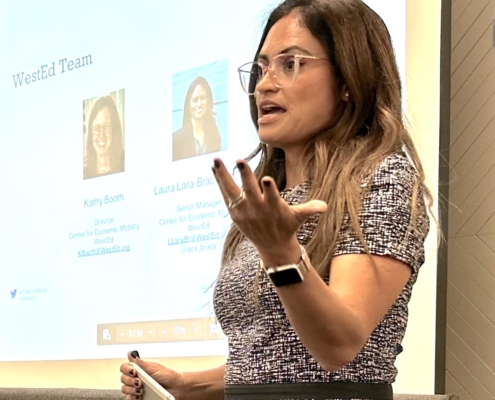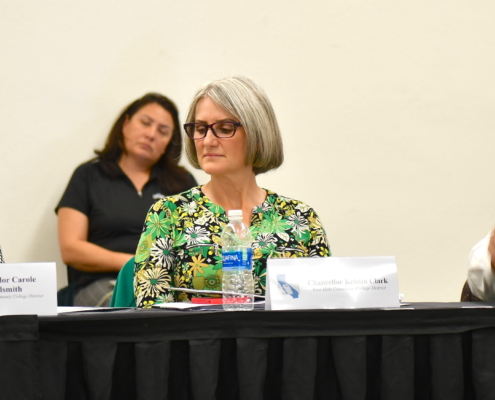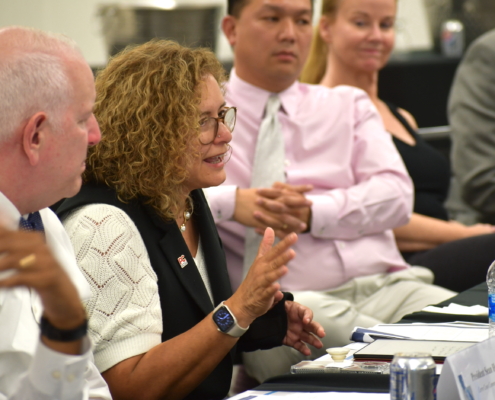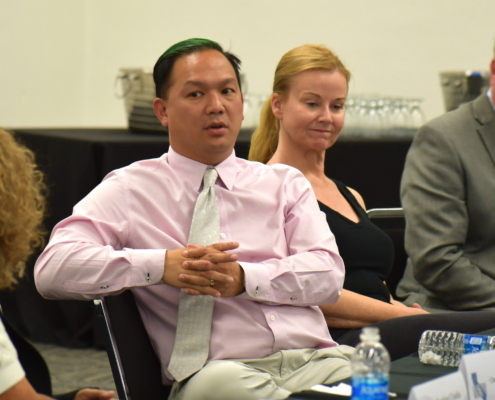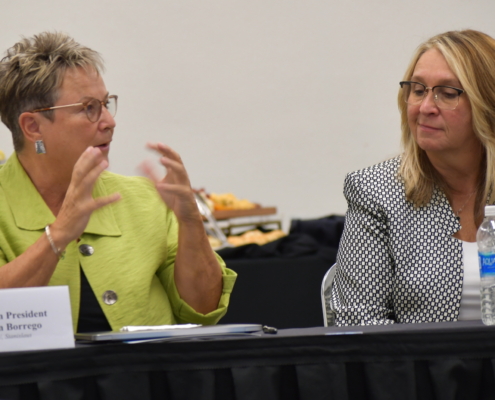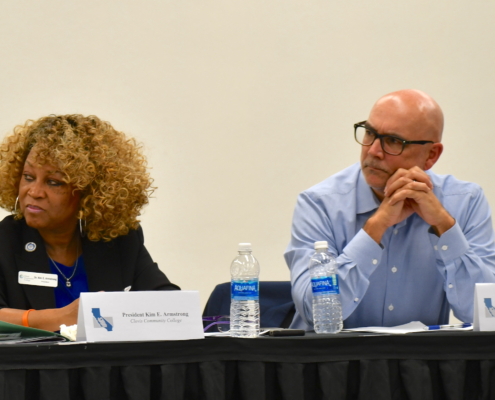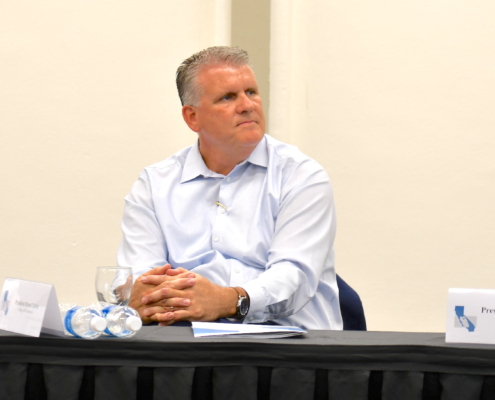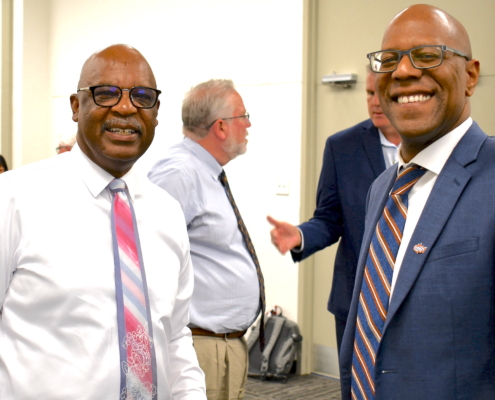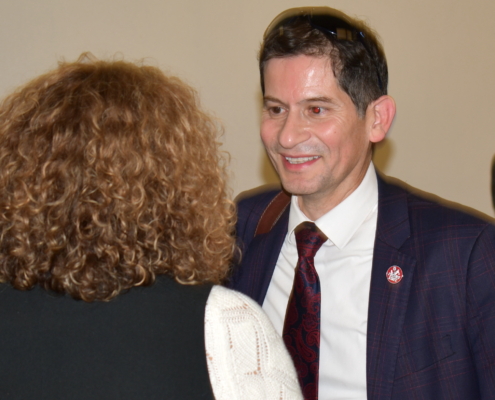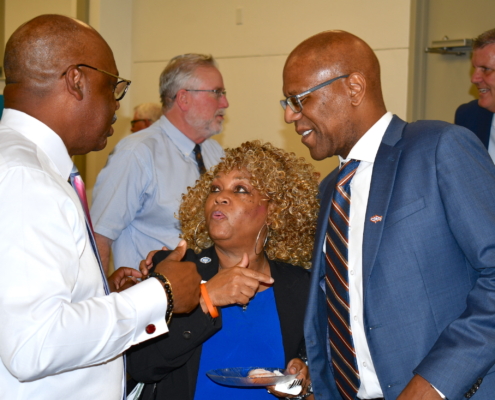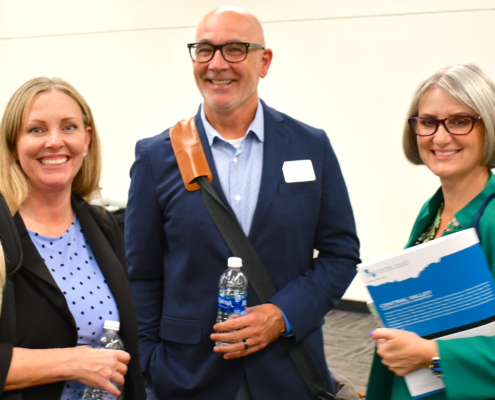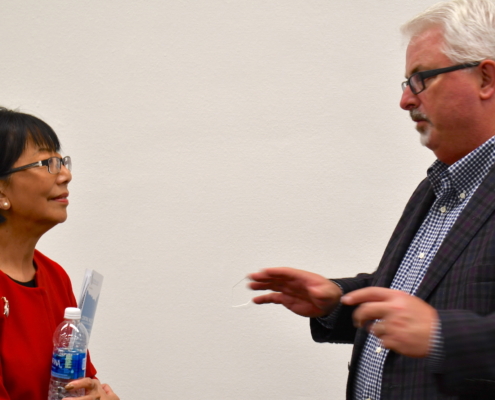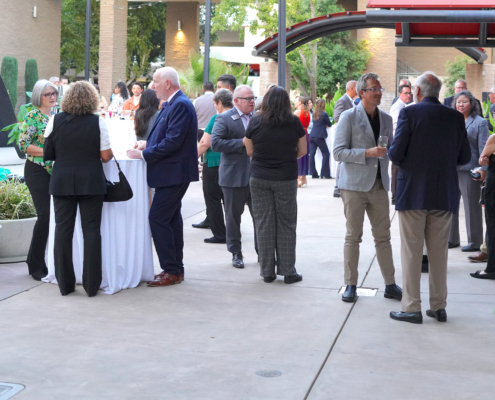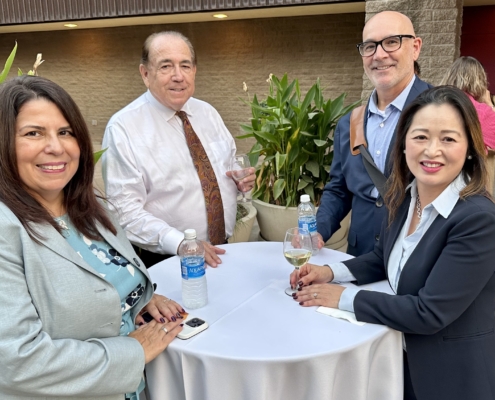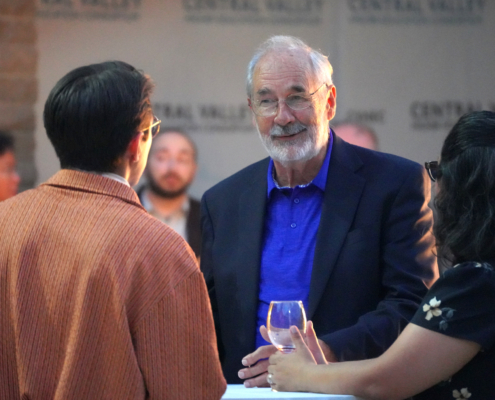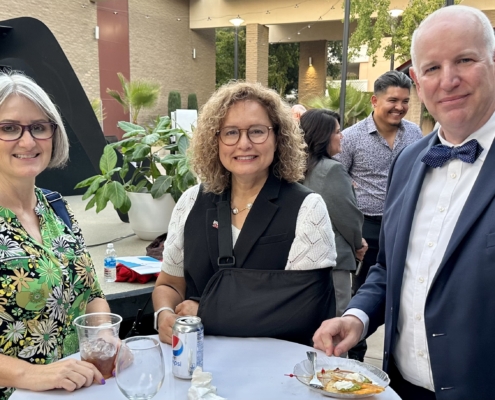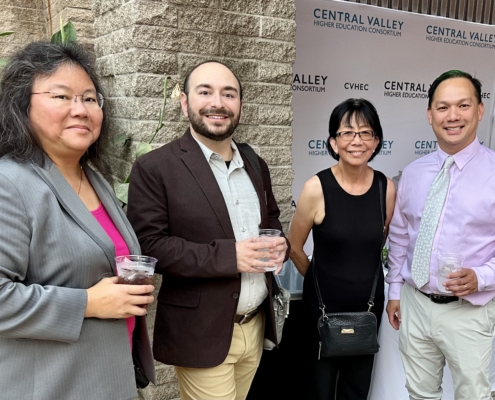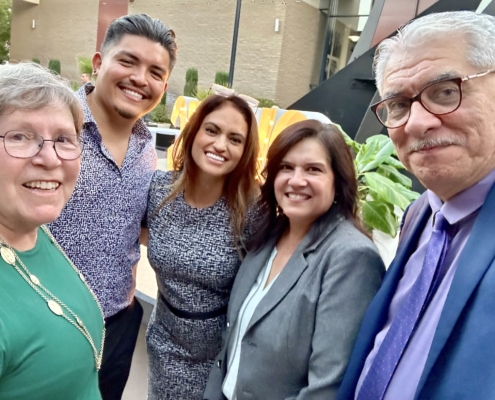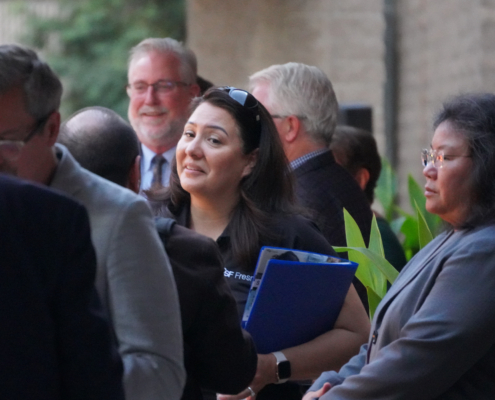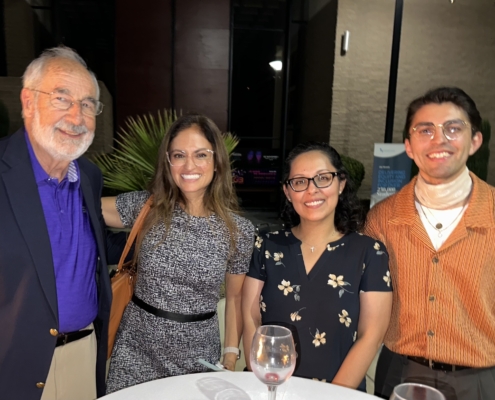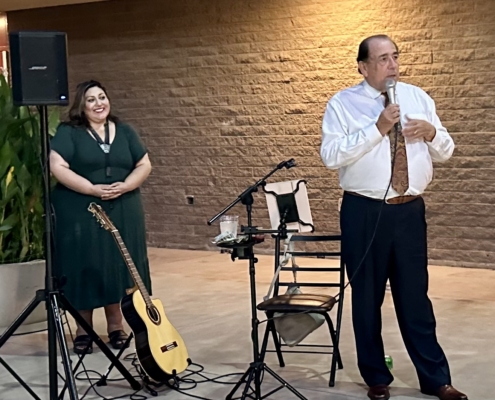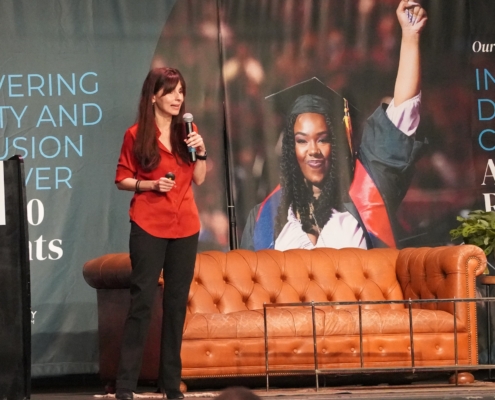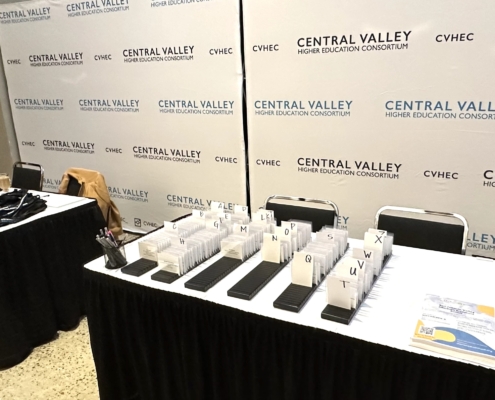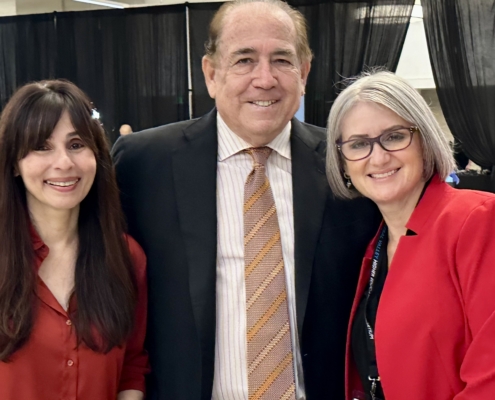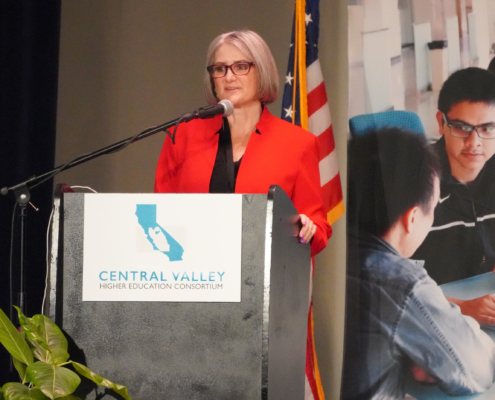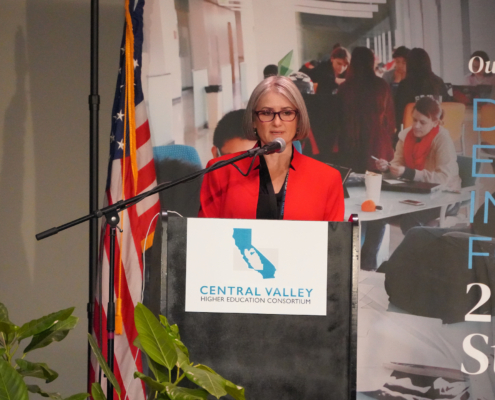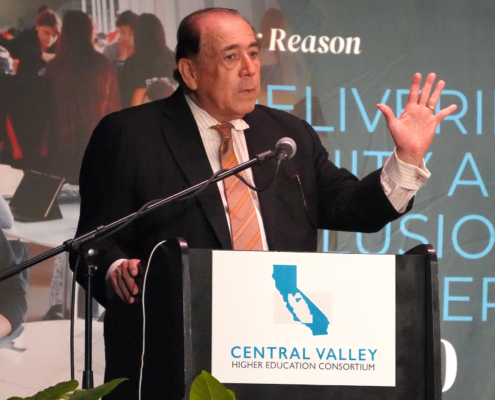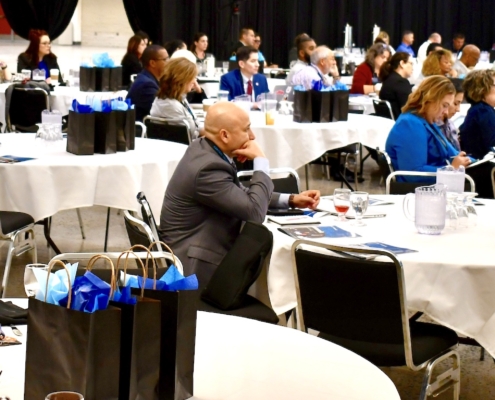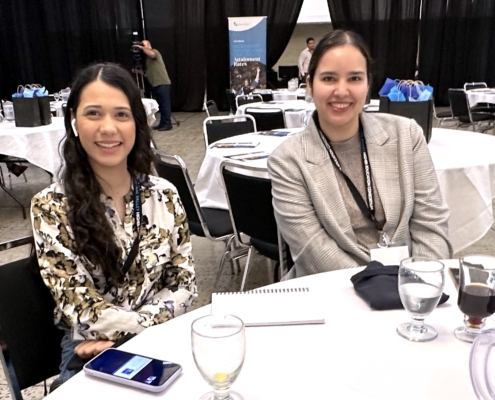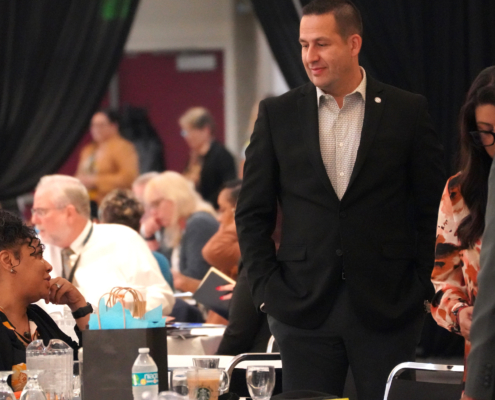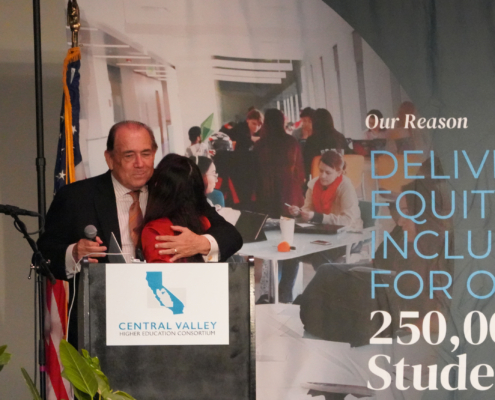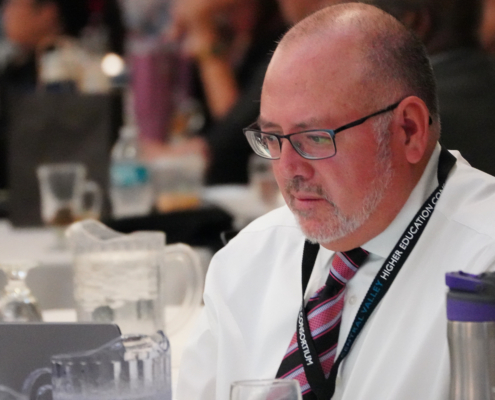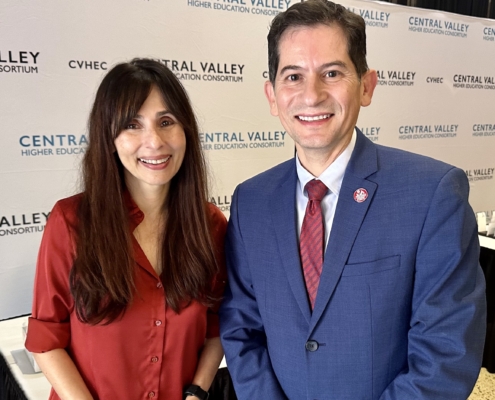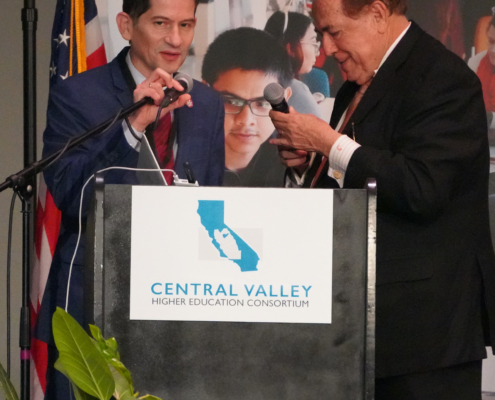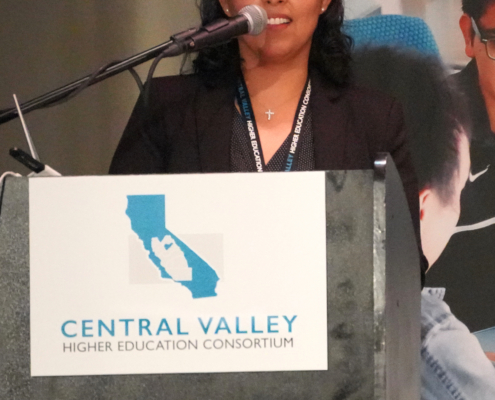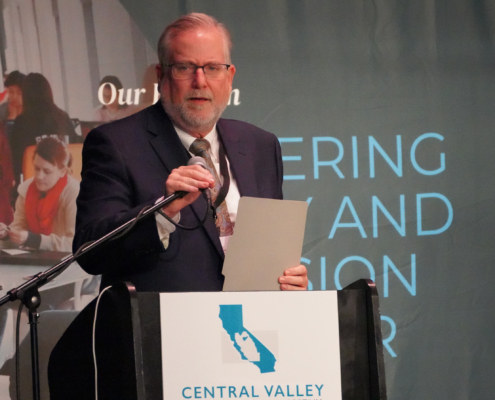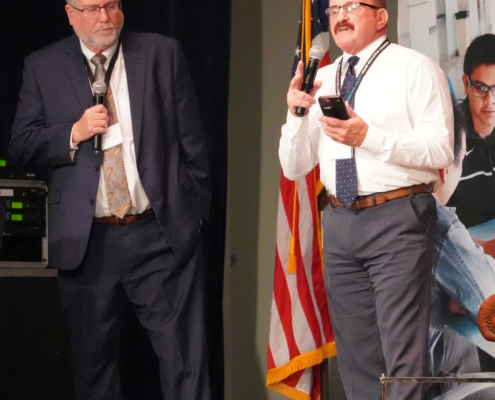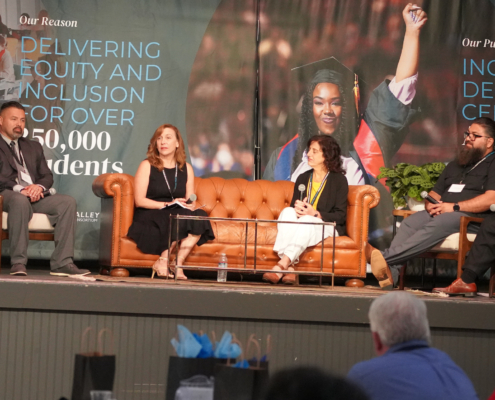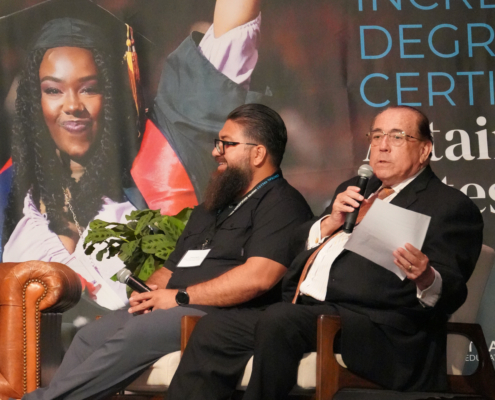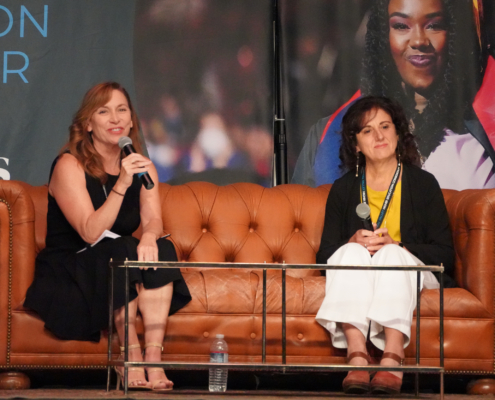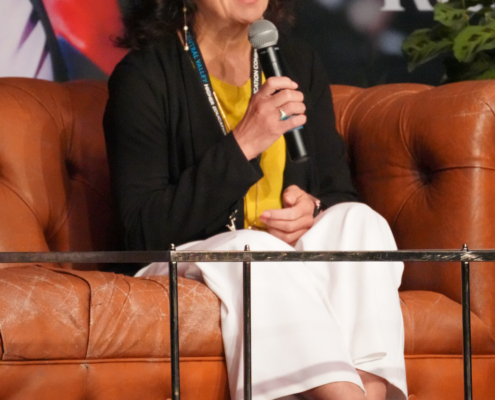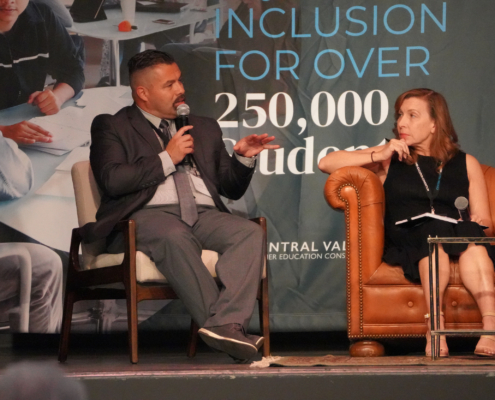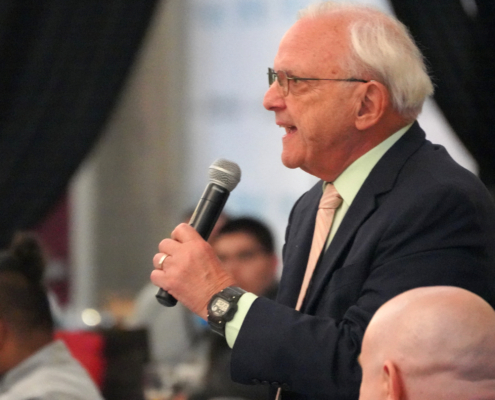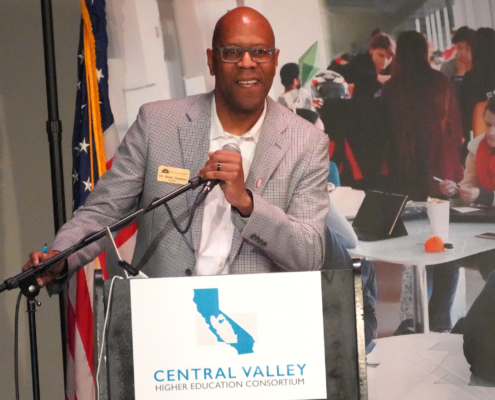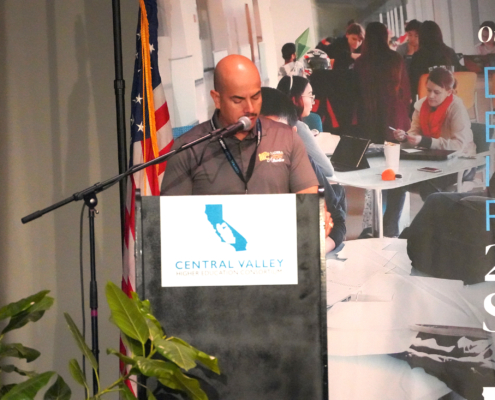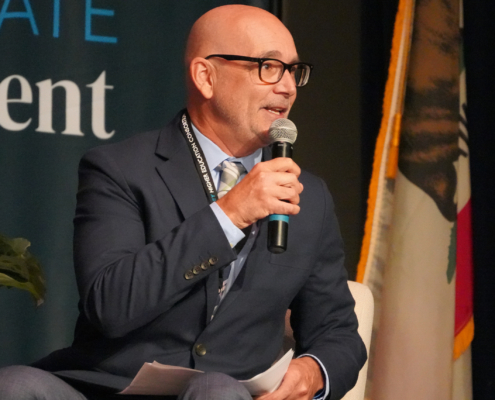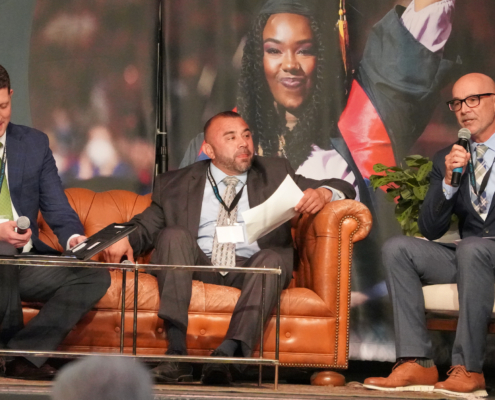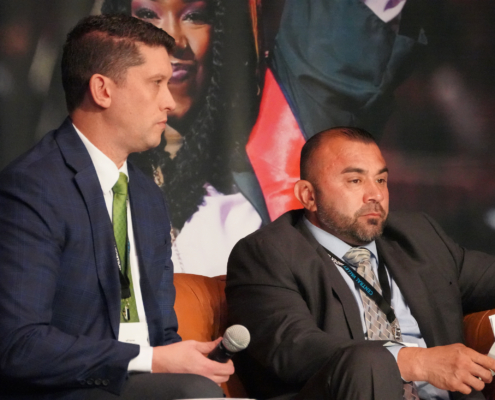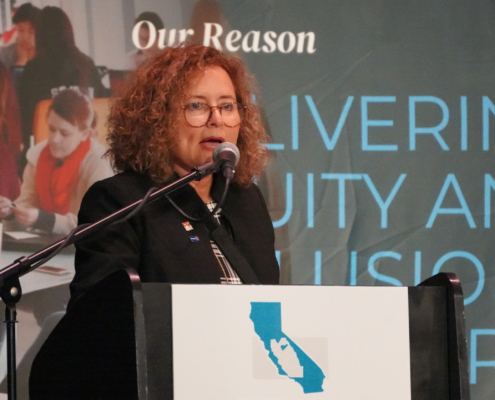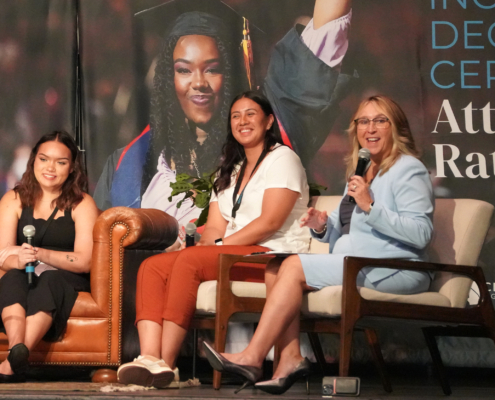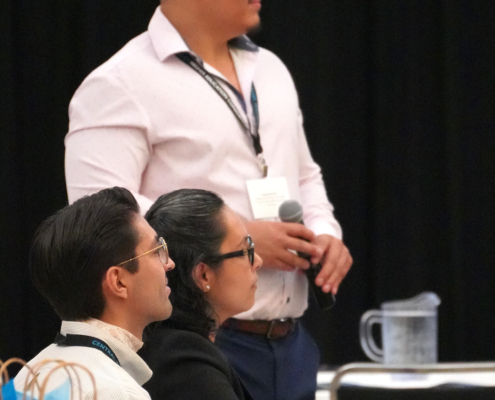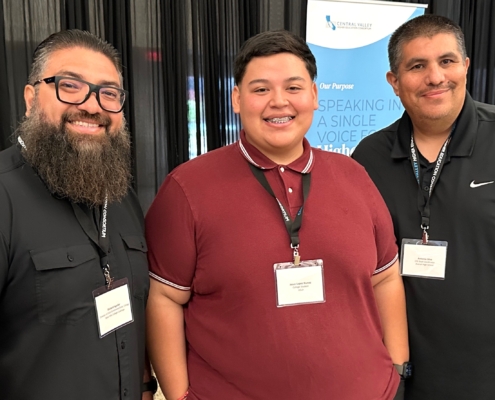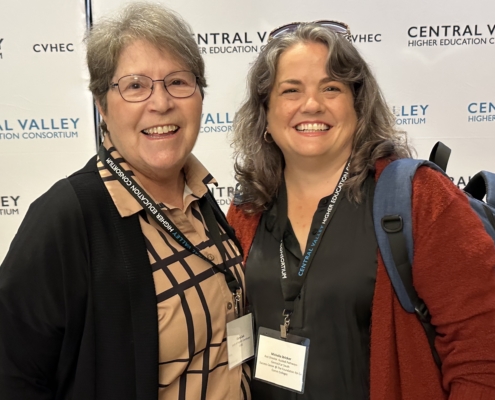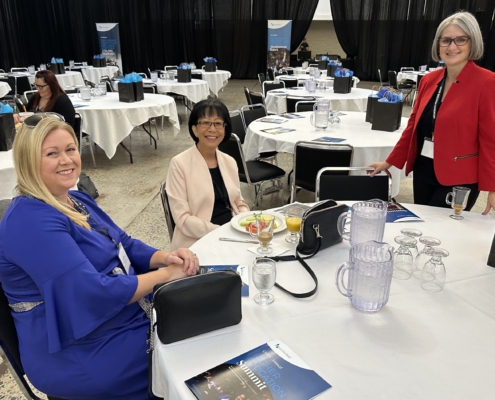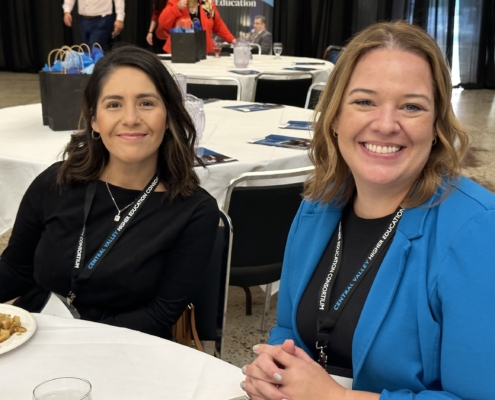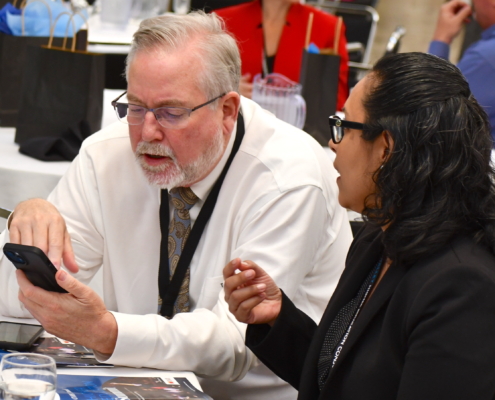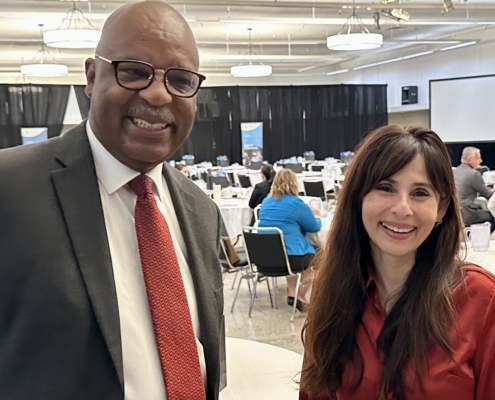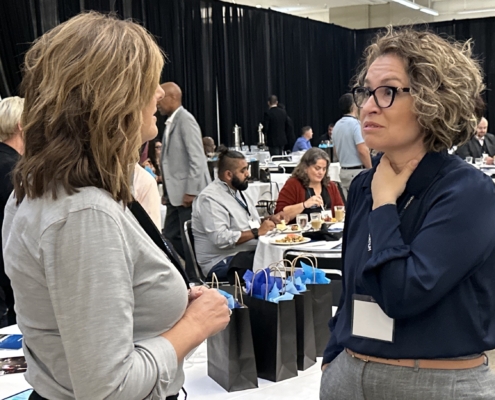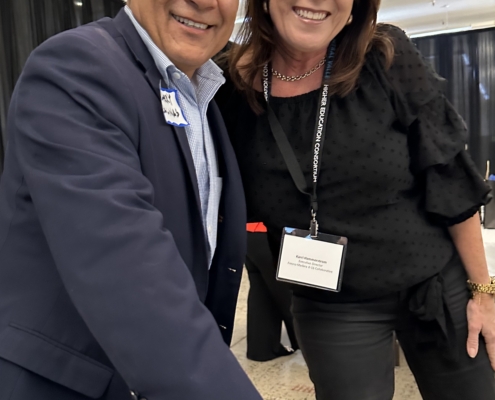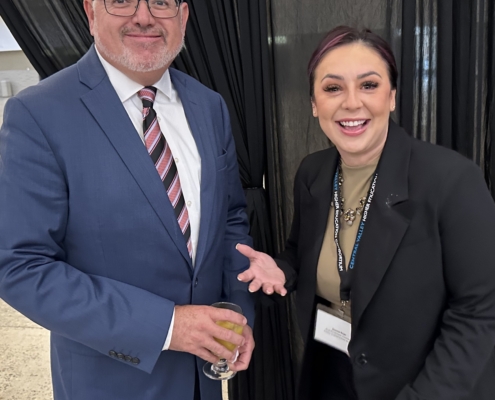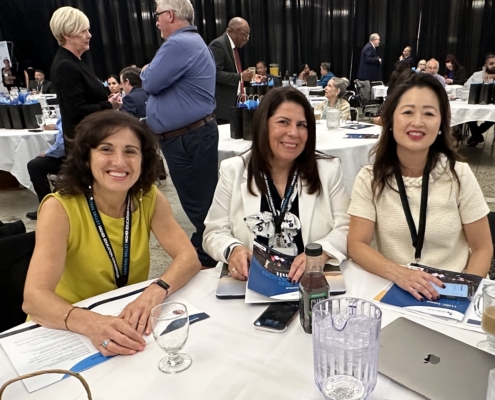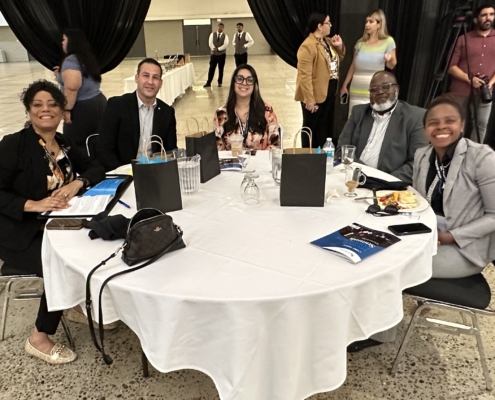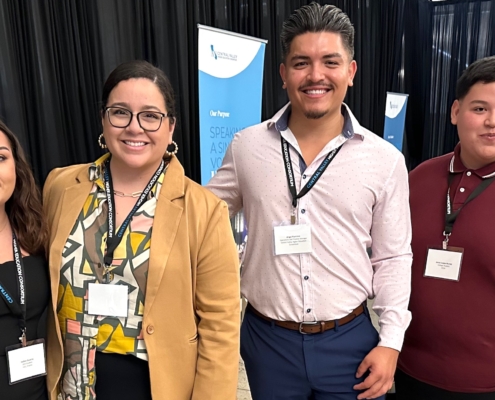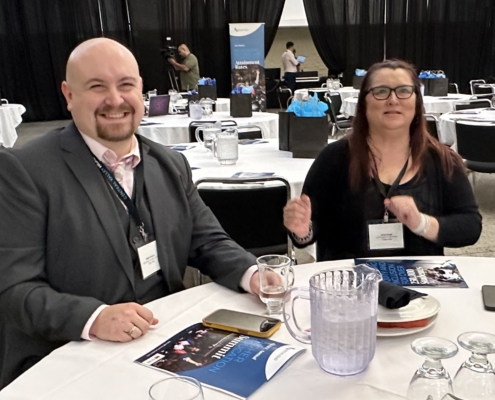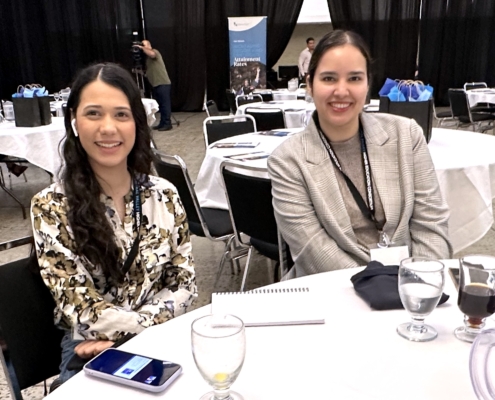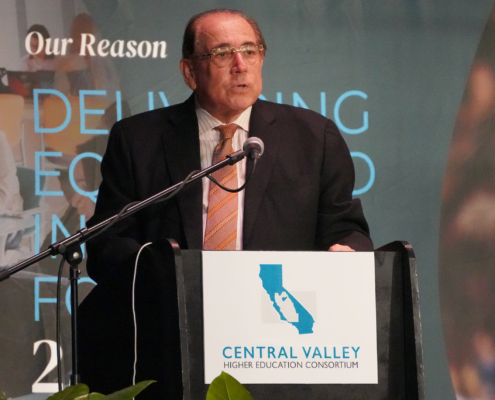MATH TASK FORCE: ‘Something extraordinary’ (Jan. 26 wrap)
Modesto Junior College math professor Tina Akers-Porter discusses her strand group’s deliberations at “The Central Valley Way to AB1705 Success” Convening Jan. 26 where a call for a “principals task force” by Orosi High School Principal Marlena Celaya would bring more secondary education voices to the table.
‘Something extraordinary is happening in math in California’s Central Valley’
Math Task Force latest AB1705 session leads to calls
for more data, high school input, re-convene April 19
BY TOM URIBES
CVHEC Media/Communications Coordinator
Realizing that state guidance surrounding Assembly Bill 1705 remains elusive, valley community college math educators and officials forged ahead at “The Central Valley Way to AB1705 Success” convening Jan. 26 in Fresno with a determined and unified mindset to develop implementation plans that will serve the best interests of their students including a follow-up session set for April.
In addition, the Central Valley Higher Education Consortium (CVHEC) Math Task Force discussion centered around five strands of curriculum planning for implementation before the law goes into effect July 1, two aspects emerged at the lively day-long work session: the increased participation of institutional researchers for pertinent data-collecting and a call for a “principal’s task force” to bring upper secondary education voices to the table.
Presented by CVHEC, the convening — the latest in a series of deliberations since fall — was attended by 82 representatives from the consortium’s 19-member community colleges, one high school principal and campus research professionals.
They agreed to reconvene April 19 for reports on follow-up work that will occur as a result of this most recent event. Registration for that event will open next month with additional details forthcoming.
Facilitated by the Charles A. Dana Center at the University of Texas at Austin, the session last month reviewed five strands of curriculum planning: Validating Prerequisites; Designing Precalculus for 2025; Math Support Outside and Inside the Classroom; Building an AB 1705 Campus Team; and Guided Self-Placement.
“With tensions high and little guidance surrounding AB1705, the 19 community colleges and districts that comprise the CVHEC nine-county region are rolling up their sleeves and getting to work on this math movement the ‘Central Valley Way’,” summarized Tammi Perez-Rice of the Dana Center.
Perez-Rice, who co-facilitated the event, said the convening was solely dedicated to working and planning at a regional and institutional level in two parts. The first part was dedicated to expanding the five work groups that emerged from the Nov. 17 webinar and creating a plan to move forward. The second half of the convening was devoted to institutional planning.
“The fruits produced from these convenings are already being felt around the region,” Perez-Rice said. “The plans and implementations emerging from these convenings are more than just a response to AB705 and AB1705; they cultivate systemic reforms that will benefit all students in the CVHEC region and beyond.”
John Spevak, CVHEC regional coordinator who oversees the consortium’s Math Task Force and co-facilitator of the Jan. 26 gathering, said in the short-term, the five strands work groups will continue to communicate and provide updates in preparation for the April 19 convening. The strand leads are preparing summaries of their Jan. 26 breakout discussions and member college teams are preparing summaries of the tentative plans they developed in the afternoon breakout sessions for oral reports in April.
“In the longer term, our Math Task Force will continue to monitor what the California Community College Chancellor’s Office says, while mainly going forward with our own Central Valley approach to the five strands.”
That “Central Valley Way” stems from the work undertaken by the CVHEC Math task Force, first formed in 2019, in the past year that was intensified with four work sessions beginning Oct. 6 in a virtual convening with CCC vice-chancellor Eric Cooper. The first in-person session followed Oct. 13 in Fresno and another virtual session was held in two parts Nov. 17 before the Jan. 26 session.
These sessions may represent the only concerted effort by a region’s community college math community actively meeting to collaborate across campus boundaries for ways to unite as one voice and determine a curriculum course of action that meets the law’s intent, Spevak said.
“We at CVHEC, along with the Dana Center representatives and our College Bridge partners in the Math Bridge Program, feel that something extraordinary is happening in math in the Central Valley of California,” Spevak said.
After the Jan. 26 session ended, Perez-Rice reiterated a point she made the first time she visited Fresno for the first in-person convening last fall:
“This collaboration today was amazing. As I travel and talk to math faculty all over the country, what I see pulsating from the CVHEC community here in Central California is just compassion; caring about their students; putting their students first; understanding what their students need; and more importantly collaborating with each other working across institutions to make things happen.”
Inviting secondary ed voices to ‘align syllabi’
A key development of the convening was the assertion and agreement that a crucial next step is “to involve high schools in the discussion and determine how to breakdown barriers between systems for a cohesive collaborative effort to put students first across the state of California,” a message delivered by Marlena Celaya, principal of Orosi High School who was the only secondary education official in attendance.
Celaya’s comments, first in a strand session and later in general comments before the assembled group, resonated with the community college professionals as she offered to lead a task force of principals/administrators who would unify with the CVHEC community college math educators for implementation strategy — to listen and hear what the needs are and how to meet those needs.
“I’m willing to lead this work because I don’t want people to go through the wars I went through teaching algebra and volunteering all my time,” said Celaya, a former math teacher at Dinuba High School. “We would want to hear from community colleges and say to them ‘what do you need?’
“We heard something from you today: ‘I want to know what courses are offered at the high school and what does that course description look like?’ Aligning syllabi is what I’d like to do,” Celaya said. “Mathematics is my passion.”
Perez-Rice said the April 19 convening promises more high school representation, with over twelve principals who are part of the Math Bridge Program by CVHEC and College Bridge being invited. Other secondary education officials from throughout the valley are welcome she said.
Participant feedback: ‘great to see we’re not alone in this …’
After the event, several participants shared their assessment of the Jan. 26 convening.
“The conversations were amazing and we really appreciated being here,” said Joshua Lewis, chair of the Bakersfield College Mathematics Dept.
“There have been so many legislative changes and so many unknowns it’s nice to see the work that other campuses are doing and realize that we’re not alone, that we have shared values; that we have shared emphasis on student learning and really care about doing right by all of our students,” he added.
Nathan Cahoon, Taft college math professor, felt that the efforts of CVHEC’s Math Task Force as exhibited at the convening is strengthening the voice of the valley’s math community which will have an impact.
“It was amazing to work with incredible professionals who have some really amazing ideas,” he said. “I know I took many good notes about ideas to implement at our college. The connections we are building here with each other will be powerful down the road as we build a cohesive effort to get some good research together that we can send to the state as one voice from all the colleges.”
Modesto Junior College math professor Marina Hernandez said coming together within the region is relished because when attending other statewide or national conferences, the focus is not as localized.
“It was very helpful to learn what other colleges in the Central Valley are doing because we share similar student population and resources characteristics and their best practices are applicable to us here in our region,” Hernandez said.
Tina Akers-Porter, Modesto Junior College math professor, said the Math Task Force work has helped her better understand what AB1705 is and what it means for her students.
“I feel like I have a better understanding of some of the challenges of the legislation and what others are worried about,” she said. “We share some of those worries but it’s great to hear different points of view on that. A byproduct of this is we are seeing how we need to support underprepared students more, inside and outside the classroom, and sharing ideas to do that.”
Shelly Getty, Taft college math faculty and a strand leader, echoed Akers-Porter: “We left knowing we are going to start some specific tutoring and targeting students for tutoring. We will try to advertise it better and recruit so students get more access to the services we already provide which will greatly impact them. We shared some good ideas on how to do that effectively.”
Marissa Martinez, Taft college math professor, said, “We have our work cut out for us. There’s a lot of things that we have to address with a lot of moving parts. Everything keeps changing but it was great to be able to see that we’re not alone in this, that we’re working together to better serve our students.”
She said this intercollegial collaboration and the feedback from the colleges helps “so we don’t have to reinvent the wheel — what worked, what didn’t work.”
Next steps? Data research
“I would say the next step is collecting our data to see how the numbers show where we are so we can prove that these courses are important for our student success,” Martinez said.
This data aspect was also a key part of the convening as institutional research professionals were invited and directly participated such as Arooj Rizvi, research analyst in the Office of Institutional research and Effectiveness at San Joaquin Delta College.
“Researchers have a monumental role in the implementation of AB 1705 because policymakers are going to depend a lot on what we are able to produce as a group or even as an institution,” Rizvi said. “Being a part of these conversations helps us to see the bigger picture, the context and the requirements of what exactly it is that we are looking for in the data.”
She said it was exciting to hear at the convening what area colleges are going through.
“I realized how similar our challenges are from institution to institution, “she said. “Working through that together and being solution-oriented is something that’s going to take all of us towards a beneficial direction. Seeing us all here today was a defining moment in history.”
Owynn Lancaster, vice president of academic strategy for CVHEC partner College Bridge, said the event was “a huge success seeing folks come together from math to talk about math and really pool their resources to address actual challenges.
“The most powerful focus of change in education is always the educator,” Lancaster said. “I know everything’s heaped on them but in a lot of ways they have the greatest power of the greatest agency for this.”
For more info: centralvalleyhec@gmail.com
For CVHEC media inquiries: Tom Uribes – cvheccommunications@mail.fresnostate.edu (or text 559.348.3278).
See also:
https://bit.ly/MTFconveneKSEE24
Valley’s math ed experts unite to address AB 1705 challenge for student success
The CVHEC Way to Math Success — Implementing AB1705
Math Task Force begins discussion of AB1705 implementation – Nov. 17 next
CVHEC Math Task Force meets in-person Oct. 13 for AB 1705 follow-up
NEWS RELEASE – CVHEC Math Task Force: Impactful legislation (AB 1705) Convenings Oct. 6 & 13
CVHEC Website Feature: Math Task Force Page
PHOTO GALLERY
Central Valley Transfer Project: valley’s four-year colleges collaborating
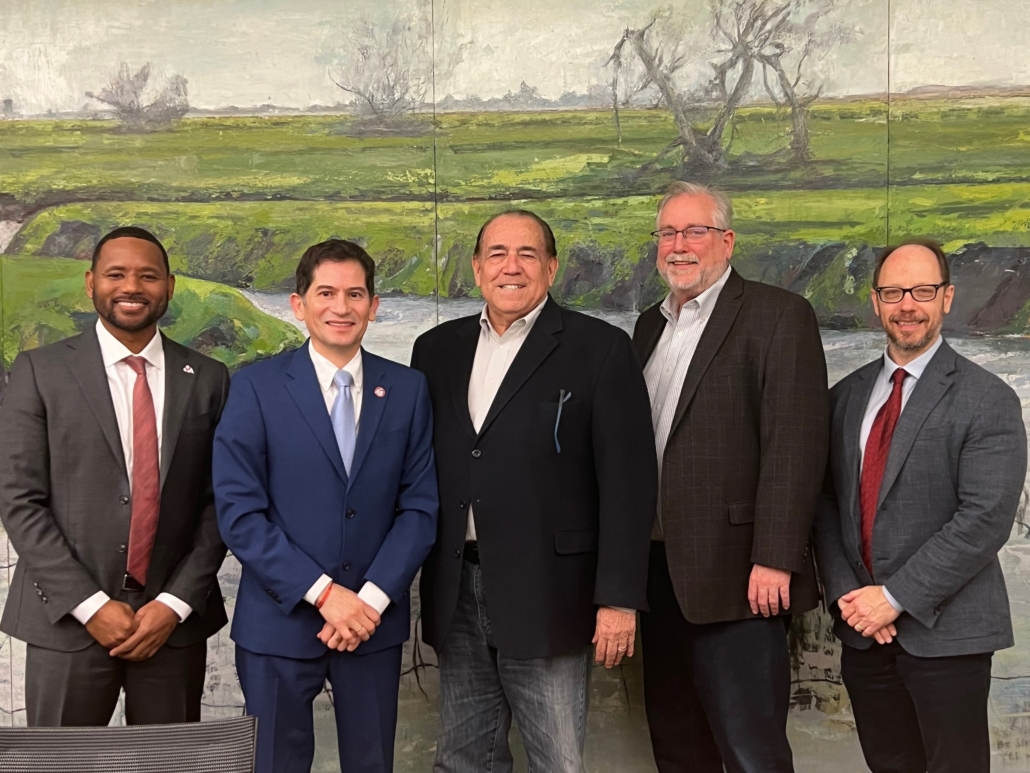
Fresno State, a founding CVHEC member, joined CVHEC’s historic Central Valley Transfer Project in January with (from left): Dr. Kent Willis, vice president of Fresno State Student Affairs and Enrollment Management; University President Saúl Jiménez-Sandoval; Dr. Benjamin Duran, CVHEC executive director; Tom Burke, CVHEC regional coordinator; and Dr. Sergio La Porta, associate dean of the Fresno State College of Arts and Humanities.
Fresno State joins in transfer ‘centerpiece’ with
11 CVHEC community colleges, 3 CSUs, UCMerced
The Central Valley Transfer Project is now partnered with the region’s three California State University campuses after Fresno State signed on in January joining Bakersfield and Stanislaus in the historic Central Valley Higher Education Consortium initiative designed to open new doors for students’ successful transfer from community college.
Along with founding partner University of California, Merced, this means the valley’s four public institutions of higher education are working in unison with 8 community colleges currently through CVHEC’s project using the groundbreaking Program Pathways Mapper software. The project has also gained the full support of the California Community College Chancellor’s Office.
The community colleges already in the CVTP, with several more expected to sign on this year, are: Bakersfield College, Clovis Community College, Madera Community College, Merced College, Porterville College, Reedley College, West Hills College-Coalinga and West Hills College-Lemoore.
The Transfer Project is also expanding participation in the north end of the Central Valley with Modesto Junior College, Columbia College and San Joaquin Delta College scheduled to begin onboard this spring for a total of 11 community college partners said Stan Carrizosa, CVHEC regional coordinator and consortium lead for the project.
All Transfer Project partners are members of the consortium with their respective chancellors and presidents serving on the CVHEC Board of Directors.
“The Transfer Project is now a centerpiece for students to both enter and transfer from community college to their four-year universities,” said Dr. Benjamín Durán, CVHEC executive director. “We are excited to share this latest progress of the project which has been featured statewide and nationally at conferences such as the Community College League of California and Complete College America.”
He added, “This innovative approach is the only one in the state that includes a University of California campus collaborating with partner California State University and community colleges in establishing transfer pathways for Central Valley students to get them to and through college in a timely manner.”
Dr. Saúl Jiménez-Sandoval, Fresno State president and CVHEC board member, said, “I’m proud that Fresno State will be a dynamic partner in the Central Valley Transfer Project, as this pathway will empower community college students to become visionary Bulldogs.”
The Fresno State agreement was finalized Jan. 17 between Durán and President Jiménez-Sandoval, with Tom Burke, CVHEC regional coordinator and Transfer Project team member; Dr. Kent Willis, vice president of Enrollment Services; and Dr. Sergio LaPorta, associate dean of the College of Arts and Humanities.
At CVHEC’s Higher Education Summit last fall, CCC Chancellor Sonya Christian announced that the statewide system has designated the Transfer Project as a demonstration project as set forth in her Vision 2030 for all California community colleges. The Transfer Project’s participating community colleges are serving as the pilot campuses with plans to implement statewide.
Carrizosa said the state budget continues to support and fund the onboarding costs for all community colleges to subscribe to the Program Pathways Mapper.
Established in 2021 with UC Merced, Merced College and Bakersfield College, the project is designed to open new doors for students to successfully transfer from community college with its Program Pathways Mapper, Carrizosa said.
He said the Program Pathways Mapper — a public facing, internet-based app that can be downloaded and accessed by the public software platform — provides unprecedented ease of access for students, counselors, advisors and parents much more so than other existing platforms.
“There are no typical requirements for access to PPM such as other internal college systems like Degree Works, Assist.Org and the CSU Transfer Planner,” he said. “These are all course tracking systems but in order to use them, students need to be successfully enrolled in college and have a student email address or other form of login to try and plan. Through PPM students simply upload the public PPM app to their devices and have immediate access.”
Carrizosa said the PPM helps simplify the transfer planning process which can be the most difficult task for many students.
“In much of our Central Valley region, as many as seven out of 10 incoming college freshmen will be first generation students to attend college,” he said. “Research shows that the most difficult task for them is often the application process itself and completing the required steps for enrollment. Systems like Degree Works and others do nothing to remove this common barrier because these systems cannot be accessed until a student successfully enrolls.”
He explained that a high school student can start the Transfer Project journey as a junior or senior by enrolling in college dual enrollment courses enabling them to complete their transfer level English and Math courses while still in high school. These units roll up with them as they enter community college and track the completion of their lower division requirements for their Associate Degree for Transfer in their chosen major via PPM.
“Students can easily select a community college they wish to attend and a major they want to pursue and the lower division courses required are sequentially laid out for them through the Program Pathways Mapper software.”
In addition, the PPM then links those lower division courses to an upper division institution of the student’s choice and shows a clear sequence of upper division courses needed to complete the degree, Carrizosa added.
“The PPM contains clear and accurate information directly from course catalogues from all participating colleges,” Carrizosa said. “The Central Valley Transfer Project is becoming an alternative continuum of courses to the traditional high school A-G or Career Technical Education continuums and is unprecedented in the state’s community college system. We call it ‘The Central Valley Way!’”
“Through the use of PPM, students complete exactly what is required of them to successfully transfer to their four-year university and they follow PPM through their last two years to degree/certificate completion,” Carrizosa said.
Baseline data results also demonstrate the promise that PPM delivers in the Transfer Project.
In a sample of 5,000 incoming freshmen to Bakersfield College in 2022 the students using the PPM increased their “percentage of on-path course completion” to over 80 percent which also closed the equity gap in this statistic for ethnic minority students when compared to their white counterparts, Carrizosa said.
“The same sample showed students using the PPM reduced the ‘number of units-to-degree’ from an average of 87 down to 67,” he added.
The project is now gearing up to expand the partnership with the College Bridge Math Project and to onboard community colleges from the northern region of the Central Valley.
For more information about the CVTP, contact Carrizosa at centralvalleyhec@gmail.com.
CVHEC media inquiries: Tom Uribes – cvheccommunications@mail.fresnostate.edu or text 559.348.3278.
Fresno State media inquiries: PIO Lisa Bell – lbell@csufresno.edu.
See:
· Pilot CVHEC/UC Merced Transfer Project improves process for students
· CVHEC Web Site Feature: Transfer Project
· Historic Transfer Project spurs statewide movement to increase transfer rates
· HIGHER ED NEWS: College Bridge to expand Math Bridge; CVHEC Transfer Project
• A-G
Kern Master’s Upskilling Program: 2nd cohort graduates – next cohort recruitment underway
Two cohorts from the Kern Master’s Upskilling Program (MA English) are eligible to participate and walk in the 2024 National University Commencement May 18 at Petco Park in San Diego. The program’s high school teacher participants are now qualified to teach English dual enrollment community college courses on their respective campuses. A third English cohort and the first Kern math cohort graduate in June.
Kern Master’s Upskilling Program
reaches another milestone
Second English cohort graduation – recruitment underway for a fall math cohort
The Kern Master’s Upskilling Program for high school teachers seeking a master’s degree in English or Math that qualifies them to teach dual enrollment courses at their respective campuses reached its second milestone last month when 11 participants completed post-baccalaureate requirements in English through National University.
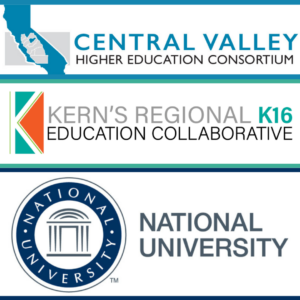 Formally known as the Dual Enrollment Teacher Upskilling Pathway for English and Mathematics, the Central Valley Higher Education Consortium initiative is in partnership with the Kern Regional K-16 Education Collaborative that was funded as part of an $18 million statewide competitive grant in June 2022 to improve student progress from high school to postsecondary education and ultimately into the workforce.
Formally known as the Dual Enrollment Teacher Upskilling Pathway for English and Mathematics, the Central Valley Higher Education Consortium initiative is in partnership with the Kern Regional K-16 Education Collaborative that was funded as part of an $18 million statewide competitive grant in June 2022 to improve student progress from high school to postsecondary education and ultimately into the workforce.
The program also announced recruitment is underway for a third math cohort of 21 students to begin this fall for completion in spring 2026 though Fresno Pacific University in concert with the Kern County Superintendent of Schools (KCSOS), which serves as the administrative agent for the Kern K-16 Collaborative.
Informational meetings are set for March 21 and April 11 at 4:30 p.m.
A potential fourth English cohort pilot through CSU, Bakersfield with seven students is also in the works said Tom Burke, CVHEC’s Kern Masters Upskilling Program lead who reports that the program progress “has been very good” since it was funded two years ago.
“With the first two cohorts of English graduates to be joined by our first cohort of math graduates this summer, we are well on the way to significantly increasing the number of faculty in Kern County eligible to teach dual enrollment or community college courses in math and English,” Burke said.
The January graduation follows the first cohort of 11 English students who graduated in September for the innovative state-funded CVHEC initiative that helps reduce the cost of tuition for high school teachers to pursue a master’s degree, a state requirement to teach community college dual enrollment courses.
Each NU cohort group of students is eligible to participate and walk in the 2024 Commencement services set for Saturday, May 18, at Petco Park in San Diego, said Jessica Gladney, senior director for Partnership Development/ Workforce Education Solutions for National University,
The first Kern Master’s Upskilling Program cohort — MA, English with a specialization in Rhetoric — began in January 2023 with 13 out of 15 students completing their program in November 2023 (nine of the 13 will graduate with honors with a grade point average of 3.85 and above).
The two remaining students are currently in the process of completing their capstone, which is the culminating course of the master’s program, Gladney said.
The second Kern Master’s Upskilling Program cohort of MA, English with a specialization in Rhetoric, began in March 2023, and 10 out of 15 students completed their program in January 2024. The remaining students are currently in the process of completing their capstone course, Gladney reports.
She said each NU cohort group of students is eligible to participate and walk in the 2024 Commencement services set for Saturday, May 18, at Petco Park in San Diego.
“We are proud of these candidates and we are excited to assist with building a qualified candidate pool of eligible dual-enrollment English teachers to meet the workforce demands in the Central Valley,” Gladney said.
CVHEC, made up of 28 institutions of higher education in the valley’s nine-county region from San Joaquin to Kern counties, is one of several partners in the Kern Collaborative.
South Valley CVHEC members include California State University, Bakersfield; Kern Community College District; Bakersfield College; Cerro Coso College; Taft College; Porterville College; Fresno Pacific University; and National University.
The project also includes the CVHEC Mentor Program that pairs the master’s candidates with a community college mentor to support them along the way and help them navigate the process to becoming an adjunct community college faculty member.
Under coordinators Dr. Liz Rozell (math) and Dr. Vikash Lakhani (English), the program is still accepting community college professors to serve as mentors, Burke said.
For more details about the fall 2024 math cohort through Fresno Pacific, potential students can contact:
- Manjula Joseph, program director – manjula.joseph@fresno.edu or 559.453.2096
- Nathan Lyness, senior Outreach & Admissions representative – nathan.lyness@fresno.edu or 559.453.7183
See:
- CVHEC Teacher Upskilling Program for Master’s Degrees Supports Dual Enrollment in South Valley via Kern K-16 Collaborative Grant (June 23, 2022)
- Rozell, Lakhani Named CVHEC’s Kern Faculty Mentor Coordinators (February 22, 2023)
- CVHEC IN THE NEWS: KBAK features Kern Master’s Upskill Program (November 17, 2022)
- Tom Burke Named Kern Master’s Upskill Lead (November 16, 2022)
- Herrera to Head Kern Regional K-16 Education Collaborative (July 13, 2022)
- KCSOS Mary Barlow Announces $18.1M Workforce Grant (KCSOS press release – June 9, 2022)
- “Blurring the Lines Between High School and College: Dual Enrollment in the Central Valley”(CVHEC video – March 2022)
MEMBER NEWS: WHCCD gets federal grant for RuBICON – rural broadband
$1 million USDA grant awarded to West Hills CCD
for broadband cooperative formation
Project director recruitment underway
The West Hills Community College District (WHCCD) has received a $1 million federal grant that will play a pivotal role in establishing the Rural Broadband Initiative Cooperative Network (RuBICON), a project aimed at providing affordable broadband services to rural communities and farms in the Central Valley.
The district, a Central Valley Higher Education Consortium (CVHEC) institution member, announced the United States Department of Agriculture (USDA) award Feb. 21 as well as a search for a project director for RuBICON, which aims to empower local communities by forming a cooperative that delivers reliable and cost-effective broadband access, bridging the digital divide in the rural Central Valley.
The district said this groundbreaking endeavor draws inspiration from the historic electric co-op movement, envisioning equitable change and progress for rural America in the 21st century.
Jeff Seed, WHCCD associate vice chancellor of Information Technology, emphasized the broader impact of this grant, stating, “This is not just about broadband access – it’s about fostering sustainable farming, building robust local economies, and empowering our rural communities for the digital future.”
In a social media post, Chancellor Kristen Clark, who is also CVHEC Board of Directors chair, said, “Excited about this opportunity for the West Hills Community College District to help support high-speed broadband on the Westside of the Central Valley.”
Project RuBICON has garnered support from a diverse coalition of partners committed to assessing and delivering connectivity to rural communities in the Central Valley. The initiative will collect comprehensive data to understand current needs and identify solutions to address connectivity gaps. In addition to infrastructure development, West Hills will offer digital literacy education for local communities and leverage its Farm of the Future to create a framework for agricultural technologists, propelling the community toward Agriculture 4.0.
“This project is designed to facilitate cost-effective broadband deployment, with the goal of serving as a model that can be replicated across the country,” Seed added.
For WHCCD media inquiries, contact Amber Myrick at 559.934.2132 or ambermyrick@whccd.edu.
See:
CVHEC SPOTLIGHT: Consortium at national DREAM Conference with CVCF

Ángel Ramírez (right) represented CVHEC in the Central Valley Community Foundation delegation of area leaders attending the Achieving the Dream Conference in Orlando Feb. 19-22 (from left): Carlos Castillo; Phong Yang; Estefania Avalos Chavez; Vianey Barraza Chavez; Julie Vue; Ángel. Not in picture: SCCCD Chancellor Carole Goldsmith.
The Central Valley Higher Education Consortium is participating this week in the 20th anniversary convening of DREAM, which brings together thousands of practitioners from hundreds of colleges “to exchange evidence-based approaches to accelerating student success in a manner that champions equity and drives economic vibrancy.”
Ángel Ramírez, director of operations and finance, is representing CVHEC in the Central Valley Community Foundation delegation of area leaders led by Julie Vue, CVCF senior program officer, attending the four-day event in Orlando, Florida
Other CVCF delegation representatives are Carlos Castillo, chief of Diversity, Equity, and Inclusion at Fresno Unified School District; Phong Yang, associate vice president for Strategic Enrollment Management at Fresno State; Estefania Avalos Chavez, board member, Higher Education For All; Vianey Barraza Chavez, director of Education Programs and Special Projects for the Education and Leadership Foundation; and Dr. Carole Goldsmith, State Center Community College District chancellor who also led a SCCCD delegation to the conference.
The conference is presented by Achieving the Dream, a national organization of more than 300 community colleges across the country partnering to build customized growth plans to address the unique challenges each institution faces.
It embodies Achieving the Dream’s longstanding belief in advancing community colleges as accessible hubs of learning, credentialing and social mobility that eliminate inequities in students’ educational and workforce outcomes.
Through plenary sessions with critically acclaimed scholars, educators, and activists and breakout sessions with higher education thought leaders at the Orlando gathering, a nationwide network of colleagues are sharing 20 years’ worth of lessons learned in the student success field and promoting a vision of higher education as an engine for equity and a catalyst for community transformation.
The Central Valley Community Foundation, the only accredited community foundation in the region, drives strategic investments and offers best-in-class charitable tools to connect donors to the causes they care most about with $140 Million in assets under management.
MEMBER NEWS: 2023 HEED Award Recipients
CVHEC members Fresno State and UC Merced
honored with 2023 diversity award
Two Central Valley Higher Education Consortium members – Fresno State and the University of California, Merced – are among 108 national recipients of the Higher Education Excellence in Diversity (HEED) Award presented annually by The Insight Into Diversity Magazine recognizing colleges and universities that demonstrate an outstanding commitment to diversity.
The oldest and largest diversity publication in higher education recognized Fresno State for a 10th consecutive year. UC Merced, the most diverse in the University of California system, was praised for its efforts to support and strengthen retention and graduation rates for historically underrepresented and first-generation college students.
The HEED recipients are featured in the November/December 2023 magazine issue. Insight Into Diversity magazine advances best practices in diversity, equity, and inclusion (DEI) in higher education.
Through thought-provoking print and online articles, Insight shares expert advice, valuable resources, in-depth profiles of top DEI programs at colleges and universities and headline news to help keep readers informed and empower them to advance DEI initiatives at their institutions.
Created in 2012 the HEED Award is the only national honor to recognize institutions of higher education for their outstanding commitment to diversity, equity, and inclusion.
Fresno State and Stanislaus State are designated Hispanic Serving Institutions.
For details of each member’s award, see:
CVHEC Summit 2023 wrap: a myriad of takeaways for participants
Porterville College President Claudia Habib (third from left) introduced CVHEC Summit student panelists Hailee Guerra, Araceli Tilley, Jesús López Nuñez, Alondra Veloz and moderator Dr. Carole Goldsmith, chancellor of the State Center Community College District.
Student panelist ‘earns’ a trip to CCLC to share
her transfer experiences statewide
BY TOM URIBES
CVHEC Communications/Media Coordinator
See CVHEC Summit Media Coverage: KVPR Radio and GV Wire. (MORE)
For Araceli Tilley, an alumna of Merced College, the Program Pathway Mapper used by the CVHEC Transfer Project proved to be not only useful for her transfer to UC Merced in fall 2022, it provided her an easy way to map her college courses for her final two years of college at UC Merced that is leading up to graduation in May 2024 with a degree in psychology.
Araceli shared her experiences on the student panel at the Central Valley Higher Education Consortium Summit 2023 held in Fresno Oct. 20 where the breadth and depth of CVHEC activities such as the Transfer Project were showcased. The summit is sponsored by College Futures Foundation.
She was joined by four other students who shared their experiences in activities CVHEC has sponsored and how much their success could be attributed to those initiatives: Hailee Guerra, Araceli Tilley, Jesús López Nuñez and Alondra Veloz.
“The mapper provided a straight path that really helped me out, especially because counseling and advising is super impacted at many colleges and you don’t always get to meet in-person with advisors so it was nice that I was able to self-direct using it,” Araceli said.
“And since I worked at Merced College as an outreach ambassador, I was able to help other students showing them how it works. It’s a very useful tool, especially for students who are self-directed.”
From a major announcement to kick off the day to the student testimonials, the CVHEC Summit Oct. 20 at the Fresno Convention Center accomplished its goal of convening educators and community leaders to continue developing a unified voice for higher ed issues.
“The student panel was a glimpse into the reason why educators dedicate themselves to this profession,” said Dr. Benjamín Durán, CVHEC executive director.
Araceli’s assessment of Program Mapper and how it helped her plan courses throughout college earned her an invitation by Stan Carrizosa, CVHEC regional coordinator who is the lead for the consortium’s Transfer Project, to participate in the presentation his team will make to the Community College League of California Annual Convention Nov. 16 in Indian Wells.
“I’m very excited about going to the Indian Wells conference,” Araceli said. “I didn’t expect to get asked to go to another conference but it’s a great opportunity to voice my experiences as a transfer student and how the Mapper tool helped me.”
But a key highlight of the summit came early in the day as Dr. Sonya Christian, chancellor of the California Community Colleges, returned “home” to deliver the summit keynote.
In presenting on the CCC Vision 2023 strategy plan, she announced the new Central Valley Transfer Pathways Demonstration Project, evolving from CVHEC’s own Transfer Project, to help community college students streamline the transfer process to four-year. (See story).
“As expected, Chancellor Christian’s presentation was inspiring and reflected her commitment to students in the state,” Duran said.
PHOTO GALLERIES for the CVHEC Board of Trustees and Summit Reception (Oct. 19) and
the Central Valley Higher Education Summit (Oct.20)
at the Fresno Convention Center:
CVHEC turns college age!
CVHEC’s 18th year symbolizes continued strength
speaking in a single voice for Central Valley students
The Central Valley Higher Education Consortium (CVHEC) turns “college age” this month with its 18th anniversary today, August 5.
And despite enduring perhaps its most uncertain year due to the coronavirus pandemic, the consortium of 28 colleges and universities from Kern to San Joaquin County has persevered, providing a support mechanism for the valley’s institution presidents and chancellors.
The occasion symbolizes the consortium’s strength and value of speaking in a single voice for the benefit of Central Valley students.
CVHEC spent the early years setting its foundation and building strategies to help reach a dual goal of improving Central California’s college-going culture while bridging the nine-county region’s higher education institutions into a collaborative, collective voice advocating for policies to achieve that first goal.
The concept of a Central Valley collaboration was first envisioned by Fresno State President-Emeritus John D. Welty in the late 1990s.
In 2000, funding was secured with a $110,000 grant from The James Irvine Foundation so the consortium could develop a comprehensive action plan to increase the number of Valley high school students entering college as well as community college students transferring to four-year schools. In 2001, the Consortium was awarded a two-year $850,000 grant also by The James Irvine Foundation. Incorporation papers were approved Aug. 5, 2002.
[perfectpullquote align=”right” bordertop=”false” cite=”Dr. John D. Welty” link=””color=”#33ACFF” class=”” size=”18″]“CVHEC made it possible for institutions to begin cooperating and to seek solutions to issues surrounding the college-going rates…”[/perfectpullquote]
Welty was CVHEC’s first board president who worked closely with then-UC Merced Chancellor Carol Tomlinson-Keasey and area community college officials to create the consortium, including then-Merced Community College President Dr. Benjamin T. Duran, who is now CVHEC’s executive director.
“The notion of a collaborative intersegmental higher education organization with an active board of directors composed of member institutions’ presidents and chancellors was unthought of at the time,” said Duran who bestowed president-emeritus of Merced Community College in 2012 and was brought out of retirement to lead CVHEC in 2016.
“Under President Welty’s leadership, the consortium developed into an organization made up of equals where the president of a small 3,000 student community college holds the same stature and respect as that of a president or chancellor of a large 29,000 student university,” Duran said. “This unique culture allows regional leaders to speak with a single voice about higher education issues and challenges facing the nine-county region of CVHEC.”
Welty recalls both the frustration that led to the formation of the novel idea and the satisfaction of seeing the fruits of like-minded higher ed leaders from San Joaquin to Kern County embracing the concept.
“In the late 1990’s it was clear that the California Master Plan for Higher Education was not serving Central California very well,” Dr. Welty said in a recent interview for the 18th anniversary milestone. “College-going rates were among the lowest in the state. There was a lack of professional programs which was leading to shortages in health care professionals along with several other areas.”
In its first 15 years, CVHEC’s focus was to bring together postsecondary institutions to improve the college-going rate especially for underserved students and to make transfer among institutions easier.
“The task was not easy because there was not a culture of collaboration at the time,” Welty said. “CVHEC made it possible for institutions to begin cooperating and to seek solutions to issues surrounding the college going rates along with other critical issues facing post-secondary institutions.”
Today, CVHEC has become a higher education organization well-respected nationally and throughout California as it works to equitably increase certificate and degree attainment rates with its success supported by the College Futures Foundation in California and The Lumina Foundation nationally. The Consortium also has partnered with advocacy and policy groups like the Charles A. Dana Center at the University of Texas, Austin, Complete College America, California Acceleration Project and the California Community Colleges Chancellor’s Office.
“The consortium has become known for assisting Central Valley colleges and universities to become state leaders in the implementation of legislation and executive orders leading to the elimination of developmental courses in English and mathematics while implementing co-requisite support courses that changed the lives of many students for the best,” Duran said.
“Now, in the midst of this historic pandemic, a new powerful role is emerging for the consortium: providing an ongoing dialogue between member institutions to face the challenges of converting to a virtual platform for the delivery of instruction and student services,” said Dr. Stu Van Horn, West Hills Community College District chancellor and current CVHEC Board of Directors president.
“As CVHEC enters its 18th year in the Central Valley, students and communities in the region will continue to benefit from the work of the consortium and its board of directors,” he said.
Welty concurs.
“It has been very gratifying to see the progress that has been made in postsecondary institutions during the past eighteen years,” said the former president who retired in 2013 following a 20-year tenure as Fresno State’s 7th president. Welty oversaw his institution’s centennial celebration the year before.
“In addition to additional community colleges, UC Merced was founded and the California Health Sciences University has launched a medical school,” Welty added. “Congratulations to all of the post-secondary leaders in Central California who have demonstrated that collaboration among all sectors can make a difference.”
Dr. John D. Welty, Fresno State President-Emeritus who founded and steered CVHEC to incorporation on Aug. 5, 2002, was presented a painted portrait upon his retirement in 2013. The portrait, which hangs in the Henry Madden Library on campus alongside paintings of the university’s past presidents, was created by artist Joel Beery, a Fresno State graphic designer and alumnus.
• August 5, 2020 • CVHEC Digital Newsletter August 2020 issue.

